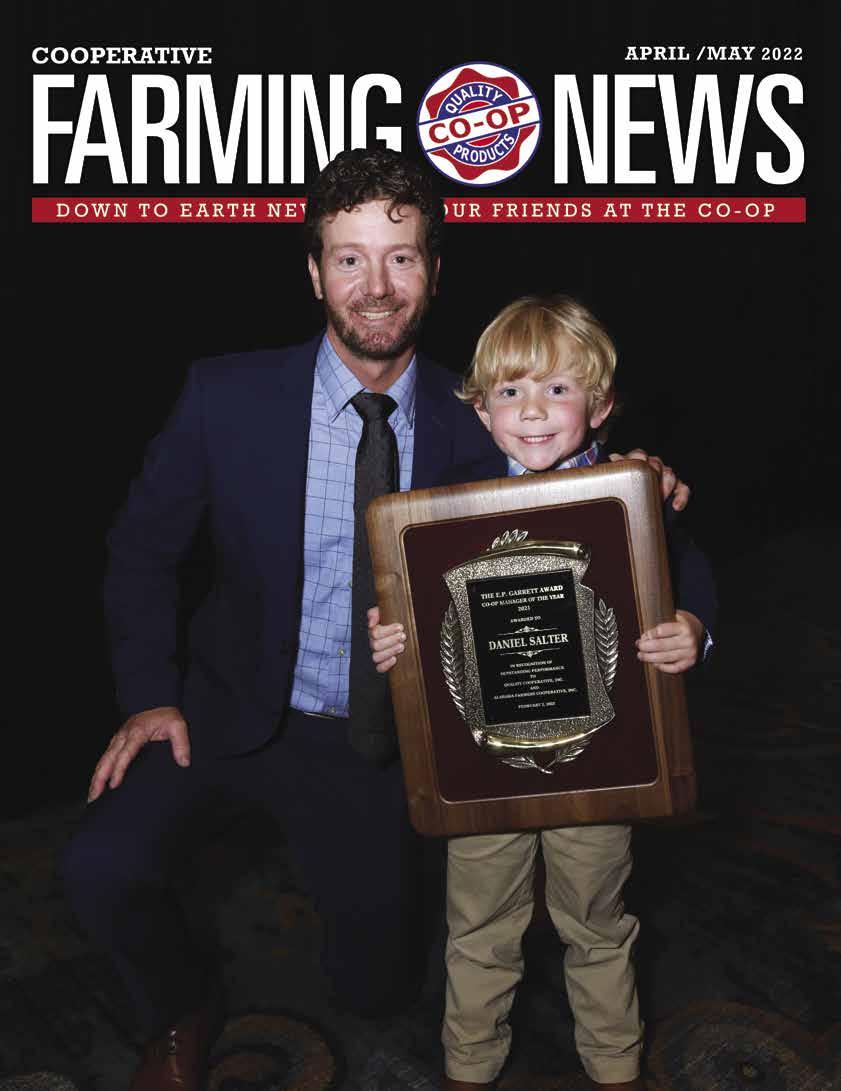
Mississippi Pinkeye 2 retains the most desirable characteristics of superior yield and disease resistance of Mississippi
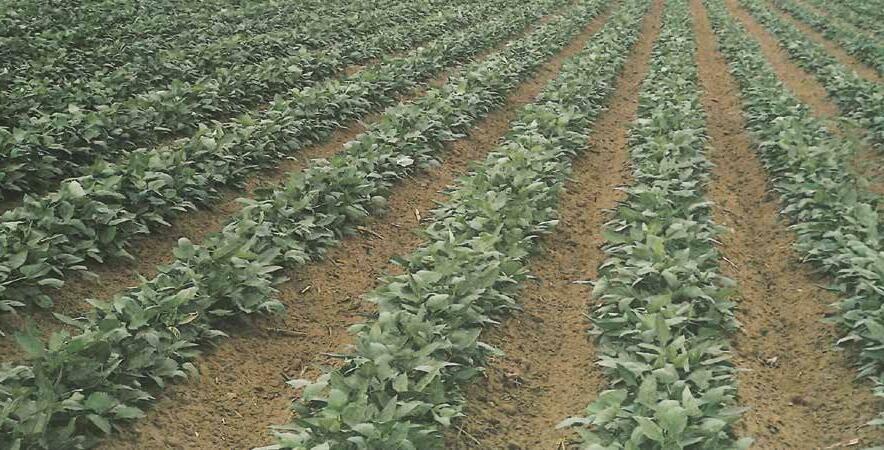
Pinkeye, with the additional benefit of improved emergence and survivability in cool, wet soils typical of early spring weather.
“I'll never plant another variety of pinkeye peas if I can't have Mississippi Pinkeye 2. I don't want any other variety. I have tried other pinkeyes, but they don't yield, cook or taste like Mississippi Pinkeye 2. I like the size of this big pea and it shells out easy. It freezes pretty and tastes like you just shelled them.
We planted late and it was a dry year, but the plants still got knee high loaded down with peas. Mississippi Pinkeye 2 - that's my pea.”
- Lisa Holmes

“Planted two varieties of pinkeye peas this year: Texas and Mississippi Pinkeye 2. I planted the second week of March.
Mississippi Pinkeye 2 was the best pea by far. The plant was larger, had longer pods and more pods per plant than the Texas, and was taller and also grew off faster. The pods had a good purple color and shelled out better. They also freeze well. Again, there were more peas per bush than the Texas plant, plus you can pick all season long.”
- Michael Anderson

“Our Mississippi Pinkeye 2 Purplehull peas were really good producers and our customers liked them. They made long pods and the peas were larger than the other varieties we planted. They mature more evenly which makes picking easier and more profitable.
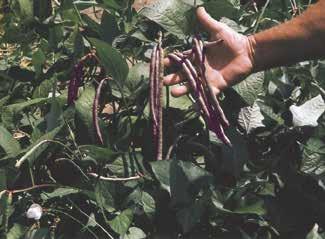

The new Mississippi Pinkeye 2 Purplehull will be a big part of my operation again next year.”
- Bob Compton
Seeds for Southern Soils

2 Cooperative Farming News NEW
RELEASE!
“I'll never plant another variety “ I ' l l n e v e r p l a n t a n o t h e r v a r i e t y of pinkeye peas if I can't have o f p i n k e y e p e a s i f I c a n ' t h a v e
Mississippi
Pinkeye M i s s i s s i p p i P i n k e y e 2 .” . ”
“I'll never plant another variety of pinkeye peas if I can't have
Mississippi
Pinkeye 2 .”
Mississippi Pinkeye 2 Purplehull Mississippi Pinkeye 2 Mississippi Purplehull UTILITY PATENT PROTECTED
CO-OP MATTERS
8 Bonnie Plants New Headquarters
9 Bonnie Plants Foundation Makes Contribution
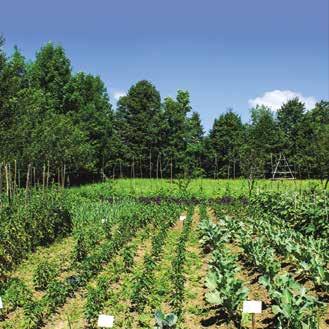

20 Co-op Corner: Future Leaders Program
48 85th Annual Membership Meeting LIFE ON THE HOMEPLACE AND IN THE COMMUNITY


58 Hubert Family Farms
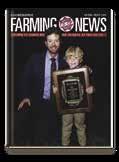
62 Miss Annie’s Kitchen + Home YOUTH MATTERS

26 FFA Sentinel: Playing in the Dirt
28 4-H Extension Corner: 4-H Tech Changemakers
31 PALS: Arcadia Elementary Joins the Clean Campus Program
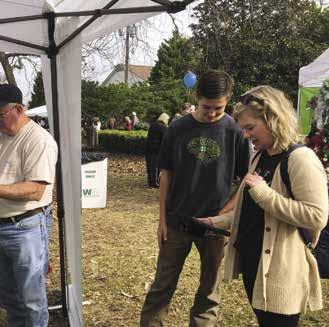
April/May 2022 3
Letter from the Editor ....................... 4 Ag Insight .......................................... Business of Farming Feeding Facts .................................... From the State Vet’s Office Homegrown with Sweet Grown What’s the Point ............................... Outdoor Logic with BioLogic Cooking with Stacy Lyn Farming Your Forest Shepherding Outdoors Southern Made Simple How’s Your Garden? Howle’s Hints.................................... Magic of Gardening Lawn & Garden Checklist Simple Times ..................................... 79 Food Safety ........................................ 83 Grazing Grace .................................... 86 The Co-op Pantry .............................. 89 What’s Happening in Alabama ........... 92 www.alafarm.com CONTENTS On the Cover: E.P. Garrett Manager of the Year Daniel Salter with son Elijah Daniel. (Photo Credit: Studio Panache) 48 50 73 58 62 28
er from the Editor

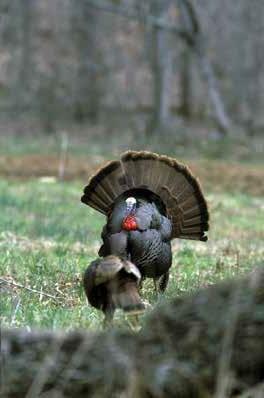
As we dive into the second issue of the year, we’re welcoming spring with open arms here at the Co-op. Our stores are gearing up to sell plants and garden supplies, especially during the Bonnie Plants Spring Sale happening April 4-16, 2022. ey’re also preparing to support farmers throughout the planting season with seed, fertilizer, technology and a smile – we know how long those days can get!
As we dive into the second issue of the year, we’re welcoming spring with open arms here at the Co-op. Our stores are gearing up to sell plants and garden supplies, especially during the Bonnie Plants Spring Sale happening April 4-16, 2022. We’re also preparing to support farmers throughout the planting season with seed, fertilizer, technology and a smile – we know how long those days can get!
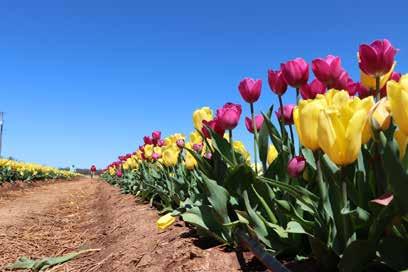
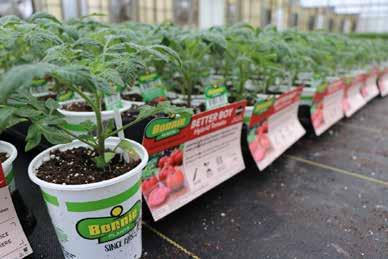
We’re excited to highlight our 85th Annual Membership Meeting in this issue –“a historic milestone” as mentioned by our Board Chairman, Ben Haynes. You’ll nd multiple articles on the event, including an overview - Where History Meets Opportunity, our keynote speaker - Dr. Delatorro McNeal, our breakfast speaker - Bre Bruggeman and more. Our 2021 E.P. Garre Manager of the Year was also announced at this event and rst-time recipient Daniel Salter of Quality Co-op, Inc. was “actually kinda shocked,” but credits the award to his employees and their hard work over the past few years.
This issue highlights our 85th Annual Membership Meeting – “a historic milestone” as mentioned by our Board Chairman, Ben Haynes. Inside, you’ll find several articles on the event so you can relive the celebration alongside us! Join us in congratulating our 2021 E.P. Garrett Manager of the Year, first-time recipient Daniel Salter of Quality Co-op, Inc. Daniel was shocked by the win but credits the award to his employees and their hard work over the past few years. Our regular features, including the new additions we began in 2022, are still bringing you quality information and stories from across the southeast. We’ve had great feedback from our new cookbook – “The Co-op Kitchen,” which is available for purchase online and at participating Co-op locations.

Our regulars, including the new additions we began in 2022 are still bringing you quality information and stories from across the southeast. We’ve also had great feedback from our new cookbook – e Co-op Kitchen, which is still available for purchase online and at participating Co-op locations.
While we’ve wrapped up celebrating this milestone year, we’re diving in to the next one with anticipation of what is to come. Spring is our busiest season. We look forward to it each year – a chance to connect with our customers and support their farms, gardens, families and livelihood. Thank you for being a loyal reader, customer and part of the AFC family.
While we’ve wrapped up celebrating this milestone year, we’re diving in to the next one with anticipation of what is to come. Spring is usually our busiest season. We look forward to it each year – a chance to connect with our customers and support their farms, gardens, families and livelihood. ank you for being a loyal reader, customer and part of the AFC family.
Samantha Hendricks Editor-in-Chief
4 Cooperative Farming News
Le
Alabama Farmers Cooperative, Inc.
Your friendly farm and garden supply store for 85 years and counting.

April/May 2022 5
Editor-in-Chief: Samantha Hendricks
Editor: Jessie Shook
Associate Editor: Mary Delph
Contributing Editor: Jade Randolph
Advertising, Editorial, Subscription and Publication O ces
121 Somerville Road NE Decatur, AL 35601-2659
P.O. Box 2227 Decatur, AL 35609-2227 256-308-1618
AFC O cers Rivers Myres, President Ben Haynes, Chairman of the Board
AFC Board of Directors
Rickey Cornu , Ma Haney, Brooks Hayes, Rick Hendricks, Bill Sanders, Je Sims, Mike Tate, David Womack
Subscription $10 per year
For subscription inquiries or change of address: P.O. Box 2227, Decatur, AL 35609-2227 or call 256-308-1623
Subscribe online at h ps://www.alafarm.com/magazine

To advertise: Wendy McFarland 334-652-9080 or email McFarlandAdVantage@gmail.com
Cooperative Farming News is published bi-monthly by Alabama Farmers Cooperative, Inc.

121 Somerville Road NE, Decatur, AL 35601-2659
P.O. Box 2227, Decatur, AL 35609-2227
Reproduction in whole or in part without wri en permission is strictly prohibited. e publisher reserves the right to refuse any advertising and will not be responsible for copy errors or misprints in advertising or editorial material, other than to publish corrections of errors in fact. Feature articles, news items and columns are published for the information of our readers from quali ed, reputable sources; however, the editors and publisher make no guarantees and assume no liability for any reader’s decision to implement any procedure, recommendation or advice printed in this publication. Photos are credited to author unless otherwise noted. Advertised sale items may not be stocked by every Quality Co-op store and prices may vary.
www.alafarm.com
Postmaster:
Please send notice of address change (enclosing latest address label) to publication
o ce: Cooperative Farming News
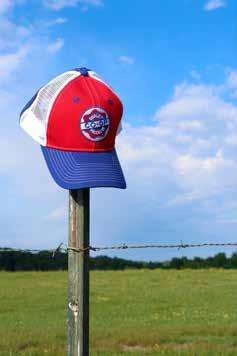
P.O. Box 2227 Decatur, AL 35609-2227
www.alafarm.com/magazine
6 Cooperative Farming News
Visit our website to subscribe to our magazine, read online, order our signature Co-op Cap or e Co-op Kitchen Cookbook. FOLLOW US: @Alafarm_coop /Alafarm
DIRECTORY OF MEMBER COOPERATIVES
ALTHA FARMERS COOPERATIVE
James Lynn, Gen. Mgr.
Phone 850-674-8194
ANDALUSIA FARMERS COOPERATIVE
Russell Lassiter, Gen. Mgr.
Phone 334-222-1851
FLORALA - Pete Blackwell, Mgr.
Phone 334-858-6142
OPP - Brandon Bledsoe, Mgr.
Phone 334-493-7715
ATMORE FARMERS COOPERATIVE
Todd Booker, Gen. Mgr.
Phone 251-368-2191
BLOUNT COUNTY FARMERS COOPERATIVE
Eric Sanders, Gen. Mgr.
Phone 205-274-2185
CENTRAL ALABAMA FARMERS COOPERATIVE
Tim Wood, Gen. Mgr.
SELMA - Thomas Reeves, Mgr.
Phone 334-874-9083
FAUNSDALE - Bryan Monk, Mgr.
Phone 334-628-2681
DEMOPOLIS - Tom Eunice, Mgr.
Phone 334-289-0155
CHEROKEE FARMERS COOPERATIVE
Seth Eubanks, Gen. Mgr.
CENTRE
Phone 256-927-3135
JACKSONVILLE - Tommy Thomas, Mgr.
Phone 256-435-3430
PIEDMONT - Kevin Bobbitt, Mgr. Phone 256-447-6560
CLAY COUNTY EXCHANGE
Jeff Kinder, Gen. Mgr. Phone 256-396-2097
COLBERT FARMERS COOPERATIVE
Daniel Waldrep, Gen. Mgr.
LEIGHTON - Tommy Sockwell, Mgr. Phone 256-446-8328
TUSCUMBIA - Chuck Hellums, Mgr. Phone 256-383-6462
DEKALB FARMERS COOPERATIVE
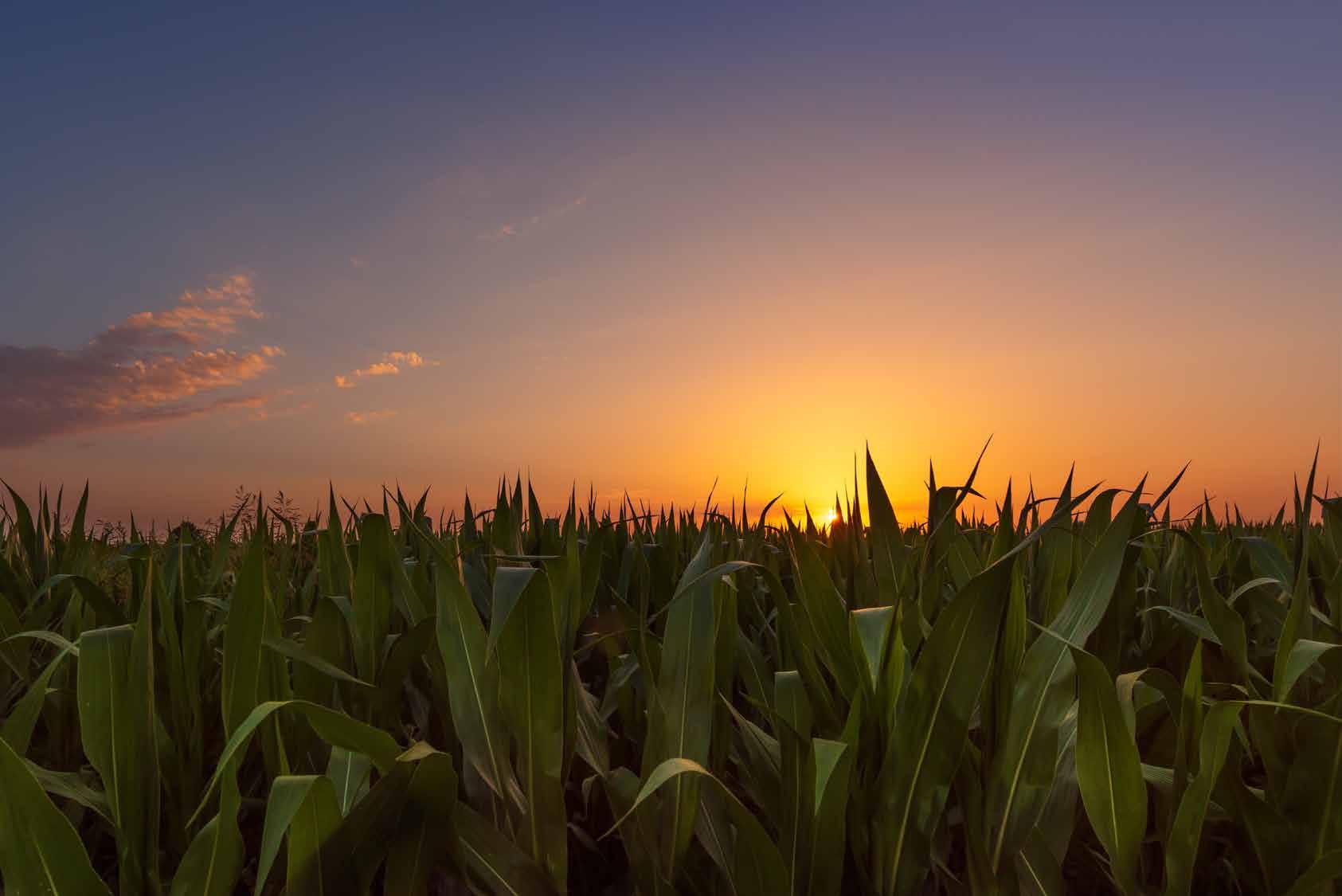
Jason Plunkett, Gen. Mgr.
RAINSVILLE
Phone 256-638-2569
CROSSVILLE - David Tierce, Mgr. Phone 256-528-7188
ALBERTVILLE - Nicholas Byars, Mgr. Phone 256-878-3261
ELBERTA FARMERS COOPERATIVE
Justin Brown, Gen. Mgr. Phone 251-986-8103
FARMERS COOPERATIVE MARKET
Doug Smith, Gen. Mgr.
FRISCO CITY - William Womack, Mgr. Phone 251-267-3175
Fertilizer / Phone 251-267-3173
LEROY - Jeff Hughston, Mgr. Phone 251-246-3512
FARMERS CO-OP OF ASHFORD
Timothy Tolar, Gen. Mgr. Phone 334-899-3263
FARMERS COOPERATIVE, INC.
Todd Lawrence, Gen. Mgr.
LIVE OAK, FL - Barry Long, Ag Div. Mgr. Phone 386-362-1459
MADISON, FL - Jerry Owens, Operations Mgr. Phone 850-973-2269
GENCO FARMERS COOPERATIVE
Ricky Wilks, Gen. Mgr.
HARTFORD - Todd Smith, Mgr. Phone 334-588-2992
WEST GENEVA - Robert Pittman, Mgr. Phone 334-898-7932
ENTERPRISE - Ricky Wilks
Phone 334-347-9007
ELBA - Colin Morris, Mgr. Phone 334-897-6972
HEADLAND PEANUT WAREHOUSE CO-OP
Jay Jones, Gen. Mgr.
Chris Hix, Store Mgr. Phone 334-693-3313
JAY PEANUT FARMERS COOPERATIVE
Ryan Williams, Gen. Mgr. Phone 850-675-4597
LUVERNE COOPERATIVE SERVICES
Perry Catrett, Gen. Mgr. Phone 334-335-5082
MADISON COUNTY COOPERATIVE
Keith Griffin, Gen. Mgr.
HAZEL GREEN - Phone 256-828-2010
MERIDIANVILLE - Matt Dunbar, Mgr. Phone 256-828-5360
NEW MARKET - Phone 256-379-2553
Ramsey Prince, Mgr.
SCOTTSBORO - Phone 256-574-1688
Patricia Rorex, Mgr.
MARION COUNTY COOPERATIVE
Steve Lann, Gen. Mgr.
HAMILTON - Phone 205-921-2631
FAYETTE - Kellie Trull, Mgr. Phone 205-932-5901
HALEYVILLE - Jessica Steward, Mgr. Phone 205-486-3794
MARSHALL FARMERS COOPERATIVE
Brian Keith, Gen. Mgr.
HOLLY POND - Phone 256-796-5337
ARAB - Mark Upton Phone 256-586-5515
MORGAN FARMERS COOPERATIVE
Bradley Hopkins, Gen. Mgr.
HARTSELLE - Jason Pealor, Mgr. Phone 256-773-6832
PIKE COUNTY COOPERATIVE
Danny Dewrell, Gen. Mgr.
GOSHEN - Phone 334-484-3441
TROY - Jeff Baron, Mgr. Phone 334-566-3882
QUALITY COOPERATIVE, INC.
Daniel Salter, Gen. Mgr. Phone 334-382-6548
TALEECON FARMERS COOPERATIVE Scott Hartley, Gen. Mgr. Phone 334-257-3930
WETUMPKA - Timothy Richardson, Mgr. Phone 334-567-4321
TALLADEGA COUNTY EXCHANGE
Chris Elliott, Gen. Mgr. Phone 256-362-2716
ASHVILLE - Allen Bice, Mgr. Phone 205-594-7042
PELL CITY - Joseph Taylor, Mgr. Phone 205-338-2821
COLUMBIANA - Barry Keller, Mgr. Phone 205-669-7082
RANDOLPH - Tim Brown, Mgr. Phone 256-357-4743
TENNESSEE VALLEY COOPERATIVE, LLC
John Curtis, President
ATHENS – Britt Christopher, Mgr. Phone 256-232-5500
LYNNVILLE, TN - Kyle Doggett, Mgr. Phone 931-527-3923
PULASKI, TN Phone 931-363-2563
Reggie Shook, Vice Pres.
FLORENCE - Robbie Neal, Mgr. Phone 256-764-8441
ELGIN - Blair Shook, Mgr. Phone 256-247-3453
John Holley, Vice Pres.
MOULTON - Greg McCannon, Mgr. Phone 256-974-9213
COURTLAND Phone 256-637-2939
TUSCALOOSA FARMERS COOPERATIVE
Wayne Gilliam, Gen. Mgr. Phone 205-339-8181
WALKER FARMERS COOPERATIVE
Cody King, Gen. Mgr. Phone 205-387-1142
PEANUTS PECANS PROPANE PEA SHELLING CATFISH *PLEASE CONTACT EACH STORE DIRECTLY FOR ALL OF THE SERVICES THEY OFFER*
Bonnie Plants Opens New State-of-the-Art Headquarters in Opelika

Media Contact: Angela Thomas
Corporate Communications Manager
The new location marks significant expansion while strengthening Bonnie’s roots in Alabama
334-473-0581
angela thomas@bonnieplants com
g g g g next chapter for our growing company,” said Mike Sutterer, president and CEO of Bonnie Plants.
OPELIKA, Ala. (Jan. 14, 2022) — Bonnie Plants unveiled today its new headquarters in Opelika with a grand opening and ribbon-cutting ceremony marking a significant expansion for the company, which is the largest grower of vegetable and herb plants for home gardens in the U.S. The new headquarters relocated from Union Springs, where the company was founded in 1918, and will strengthen Bonnie’s partnership with Auburn University by bringing new jobs and recruitment opportunities to the Auburn-Opelika community.
“We’re excited about the opportunities for future growth our new headquarters will provide as we form long-lasting community partnerships within Opelika ”
and College of Agriculture, support the University’s Center for Supply Chain Innovation and recruit interns and full-time positions at the new Opelika headquarters.
The new headquarters resembles a farmhouse and barn to evoke Bonnie’s agricultural roots, and includes several state-of-the-art and sustainable features, including a 10-foot high indoor living plant wall that will naturally purify air in the office, an abundance of natural light and indoor and outdoor workspaces.
The new headquarters will bring 60 new jobs to Opelika and will strengthen Bonnie’s recent partnership with Auburn University for education and recruitment efforts Bonnie will fund annual scholarships with Auburn University’s Harbert College of Business and College of Agriculture, support the University’s Center for Supply Chain Innovation and recruit interns and full-time positions at the new Opelika headquarters
“From Bonnie’s humble beginnings as a small farm in Union Springs, this relocation signals the next chapter for our growing company,” said Mike Sutterer, president and CEO of Bonnie Plants. “We’re excited about the opportunities for future growth our new headquarters will provide as we form long-lasting community partnerships within Opelika.”
The new headquarters resembles a farmhouse and barn to evoke Bonnie’s agricultural roots, and includes several state-of-the-art and sustainable features, including a 10-foot high indoor living plant wall that will naturally purify air in the office, an abundance of natural light and indoor and outdoor workspaces.
“This headquarters relocation cements our partnership with Bonnie and will connect our University network with a potential employer for internships and full-time recruiting,” said Dr. Jay Gogue, president of Auburn University. “We welcome Bonnie to our community and look forward to watching our talented students and alumni join the Bonnie team and advance in their careers.”
“This headquarters relocation cements our partnership with Bonnie and will connect our University network with a potential employer for internships and full-time recruiting,” said Dr Jay Gogue, president of Auburn University “We welcome Bonnie to our community and look forward to watching our talented students and alumni join the Bonnie team and advance in their careers ”
Despite the headquarters relocation, Union Springs will now play an even larger role in Bonnie’s expansion through increased investments in e-commerce operations and greenhouse facilities. More than 200 associates, including full- and part-time peak season associates, will support the increased production in Union Springs.
The new headquarters will bring 60 new jobs to Opelika and will strengthen Bonnie’s recent partnership with Auburn University for education and recruitment efforts. Bonnie will fund annual scholarships with Auburn University’s Harbert College of Business
“Bonnie Plants is a long-standing Alabama company providing employment and economic opportunity in our state for more than a century,” said Alabama Governor Kay Ivey. “I’m proud of their dedication to Alabama residents and I know this relocation will create a positive impact on our state’s agricultural developments for many years to come.”
Bonnie Plants is the leading brand of live vegetable and herb plants for home gardeners in the United States. For more information, visit bonnieplants.com.
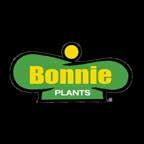
8 Cooperative Farming News
• PRESS RELEASE •
New
Corporate
Media Contact: Angela Thomas
Communications Manager 334-473-0581
Bonnie Plants Foundation Makes First Major Gift to Create a Children’s Garden at Auburn University
angela thomas@bonnieplants com
The garden will inspire agricultural education for students and the public as part of the largest classroom on the Auburn University campus
New Bonnie Plants Foundation Makes First Major Gift to Create a Children’s Garden at Auburn University
The garden will inspire agricultural education for students and the public as part of the largest classroom on the Auburn University campus
OPELIKA, Alabama (Jan. 5, 2022) — The Bonnie Plants Foundation is demonstrating its commitment to agricultural education through a multi-year donation to establish a new two-acre Children’s Garden and Pollinator Garden within Auburn University’s 16-acre Transformation Garden project.
OPELIKA, Alabama (Jan. 5, 2022) -- The Bonnie Plants Foundation is demonstrating its commitment to agricultural education through a multi-year donation to establish a new two-acre Children’s Garden and Pollinator Garden within Auburn University’s 16-acre Transformation Garden project
spaces that encourage people of all ages to learn about horticulture and the outdoors. Their support will have an impact on countless children’s lives, inspiring a passion for gardening, and contribute to numerous agricultural innovations, changing the way we grow food.”
The $1 2 million gift will support the development of the Children’s Garden which will be an innovative and imaginative resource for educational programing and community outreach

The $1.2 million gift will support the development of the Children’s Garden which will be an innovative and imaginative resource for educational programming and community outreach. “The Bonnie Plants Foundation is proud to partner with Auburn University to establish the Children’s Garden and Pollinator Garden which will be a destination for students and the community alike,” said Mike Sutterer, President and CEO of Bonnie Plants. “We’re confident this space will provide invaluable experiences to grow a love of gardening in young people and even inspire the next great generation of horticulture leaders.”
“The Bonnie Plants Foundation is proud to partner with Auburn University to establish the Children’s Garden and Pollinator Garden which will be a destination for students and the community alike,” said Mike Sutterer, President and CEO of Bonnie Plants “We’re confident this space will provide invaluable experiences to grow a love of gardening in young people and even inspire the next great generation of horticulture leaders ”
The Children’s and Pollinator Gardens will be open to the public and cultivate a love of gardening in children and families through hands-on learning experiences Auburn horticulture faculty, staff and students, in partnership with Bonnie Plants associates and local master gardeners, will regularly offer fun and educational programs for the public including tours, school field trips, summer children’s programs, and even raised bed gardening workshops
When completed, the Transformation Garden will be the largest classroom on campus, where students and faculty can use the land for teaching and research purposes. Students will learn about the history of agriculture, gain hands-on experience with new gardening methods, and test a variety of commercially sold plants. Additionally, produce harvested from the garden will go to Auburn’s Campus Dining program to give fresh fruits and vegetables back to the student population.
In these gardens, children will use their senses in the context of the plant world Through play, children will learn how to grow and care for plants, use them for food and explore other uses They will also observe both beneficial and harmful insects and learn about plant diseases and the importance of water and nutrition for plant health
The Children’s and Pollinator Gardens will be open to the public and cultivate a love of gardening in children and families through hands-on learning experiences. Auburn horticulture faculty, staff and students, in partnership with Bonnie Plants associates and local master gardeners, will regularly offer fun and educational programs for the public including tours, school field trips, summer children’s programs, and even raised bed gardening workshops. In these gardens, children will use their senses in the context of the plant world. Through play, children will learn how to grow and care for plants, use them for food and explore other uses. They will also observe both beneficial and harmful insects and learn about plant diseases and the importance of water and nutrition for plant health.
“Like the name of our garden, this generous gift from The Bonnie Plants Foundation will be truly transformational in enabling us to create a community-focused space where we can share our knowledge and love of horticulture and educate the public about our historic land-grant mission,” said Desmond Layne, head of Auburn’s Department of Horticulture “Auburn and Bonnie Plants are committed to designing outdoor spaces that encourage people of all ages to learn about horticulture and the outdoors Their support will have an impact on countless children’s lives,
The Bonnie Plants Foundation’s gift to the Transformation Garden is its first major public gift and marks the beginning of an investment in increasing healthy, affordable and local food access and horticulture education in the community.

The Bonnie Plants Foundation will receive naming rights for both the Children’s Garden and the Pollinator Garden within the Transformation Garden. Work on the garden is scheduled to begin later this year, with the initial phase of the project expected to be complete by Summer 2023. For more information about Auburn’s Transformation Garden and plans for horticulture education development, visit agriculture.auburn.edu/ research/hort/transformation-garden/.
“Like the name of our garden, this generous gift from The Bonnie Plants Foundation will be truly transformational in enabling us to create a community-focused space where we can share our knowledge and love of horticulture and educate the public about our historic land-grant mission,” said Desmond Layne, head of Auburn’s Department of Horticulture. “Auburn and Bonnie Plants are committed to designing outdoor
April/May 2022 9
• PRESS RELEASE •
AG INSIGHT
BY JIM ERICKSON
Tariffs on food products boost consumer prices
Tariffs are a type of tax that governments impose on imports for a variety of reasons, including a way to raise revenue and to protect domestic industries. This latter reason – protection – can come at a cost to domestic consumers in the form of higher prices. The resulting higher prices may stimulate or impede changes in the supply of goods, resulting in impacts on the global balance of trade called “distortions.”
A tariff may be a fixed charge per unit of product imported (specific tariff), a fixed percentage of value (ad valorem tariff), or a combination of both. Tariffs can also be used in combination with a quota, becoming a tariff-rate quota. Tariff-rate quotas provide some market access, but their often-high over-quota rates limit how much trade can occur.
Countries apply tariffs to protect domestic
industries against price competition from imports. Tariffs are higher on agricultural products than they are on non-agricultural goods in more than 90% of countries. That is because in some regions, agricultural products are often deemed “sensitive,” meaning they are important for national security reasons. Furthermore, tariffs on agriculture tend to be much higher than those on non-agricultural products. For example, South Korea’s tariff on agricultural products averages 79% compared with 4% for non-agricultural imports.

A USDA, Economic Research Service (ERS) study addressed the question of what would happen if all tariffs on agricultural trade were removed. The results of that study indicated that global trade and consumer well-being would improve most with the complete removal of tariffs.
According to the study, a removal of agricultural tariffs would spark an increase in consumer well-being – essentially the equivalent impact of income changes – of $56.3 billion.
Irrigation challenges likely to increase
Irrigation is a vital part of the U.S. agricultural economy. In 2017, irrigated farms produced more than 54% of the total value of crop sales. Irrigation allows for agricultural production in arid regions where precipitation is insufficient to meet plant water requirements. In more humid regions with variable growing-season rainfall, applied irrigation water supplements available soil moisture and provides a critical buffer against periodic drought.
Among the key trends in the growth of irrigation usage are these:
10 Cooperative Farming News
AG INSIGHT
• Irrigated acreage has expanded rapidly since the passage of the Federal Reclamation Act of 1902. Nationwide, irrigated acreage grew from less than 3 million acres in 1890 to more than 58 million acres in 2017.
• Between 1949 and 2017, the share of U.S. irrigated cropland within the Mountain and Pacific regions decreased from 77% to 44%, while the share of irrigated cropland in the Mississippi Delta and Northern Plains regions increased from 8% to 34%.

• In the Pacific, Mountain, and Northern and Southern Plains regions, the share of irrigated acres using pressurized systems rose from 37% in 1984 to 72% in 2018, with innovations focused on improved precision of applied water, reduced pressurization requirements and system automation.

However, increasing competition for water supplies, declining groundwater reserves, and shifts in climatic conditions and hydrologic flows are taxing the ability of regional water systems to meet irrigation needs. Projected increases in the frequency and severity of droughts have important implications for future agricultural water demand and supply. The resiliency of irrigated agriculture will depend on how farmers, and the institutions that influence water supply and use, adapt to increasing water scarcity.
Irrigation is a vital part of the U.S. agricultural economy. In 2017, irrigated farms produced more than 54% of the total value of crop sales. Irrigation allows for agricultural production in arid regions where precipitation is insufficient to meet plant water requirements. In more humid regions with variable growing-season rainfall, applied irrigation water supplements available soil moisture and provides a critical buffer against periodic drought.
Study emphasizes importance of inspecting food imports

A recent study by USDA’s Economic Research Service illustrated the importance of inspecting imported food imports to prevent items contaminated with pathogens or toxins from entering the nation’s food supply.
Such contamination can cause a variety of illnesses with symptoms ranging from nausea, vomiting, and diarrhea to more serious outcomes, such as renal failure, paralysis, and even death.
Further emphasizing the importance of food inspection activities is the fact that the amount of imported food for U.S. consumption has grown nearly
April/May 2022 11
80% from 2002 to more than 65 million tons in 2019, according to USDA’s. Among the key realities of the food import and inspection picture are these, according to USDA’s Global Agricultural Trade System:
• The U.S. Food and Drug Administration (FDA) estimates that annual consumption of foreign foods in the United States accounts for approximately 94% of seafood, 55% of fresh fruit, and 32% of fresh vegetables, as measured by volume of total food consumed.
• As part of its U.S. food safety oversight, FDA inspects imported foods at the border or port of entry. FDA physically examines approximately 1 to 2% of imported foods, with the exception of meat, poultry, and egg products, which are inspected by USDA. Shipments are subject to refusal into the United States if an inspector identifies an adulteration such as poisonous ingredients, disease-causing bacteria and viruses, unsafe color additives, pesticide residues, or apparent filth. Shipments may also be refused for misbranding violations, which includes false or misleading ingredients labels, origin/manufacturer information, or quality of ingredients concerns.
• This study found that more than 22,000 pathogen and toxin violations were identified from 110 countries during 2002–19. Over the study period, India had the most pathogen-related violations with 5,115 refusals. This totaled 22.9% of overall import refusals for pathogen/toxin violations. Mexico had the second-most food import refusals with 3,338 (14.9 %), followed by Vietnam with 1,929 (8.6%), Indonesia with 1,736 (7.8%), and France with 971 (4.3%).
Ag productivity growth slows
Increasing agricultural productivity is key to ensuring an abundant and affordable food supply for a growing global population while still conserving limited environmental resources such as land. A main driver of productivity growth is the development, adoption, and diffusion of new agricultural technologies and management practices.
With technological progress and innovation, not only have agricultural yields increased, but opportunities to better manage the land, labor, and capital (inputs) needed for production and reduce the environ-
mental impact of production also have emerged.
The benefits of new agricultural technologies, practices, and knowledge have been widespread across farms of different sizes, income levels, and agro-ecological environments.
In recent years, however, growth in agricultural productivity has slowed, meaning the relative rate of output to input growth has narrowed. An update to the USDA, Economic Research Service (ERS) International Agricultural Productivity data product links deceleration in the growth of agricultural output with a recent slowdown in agricultural productivity.
From 2011–19, the volume of world agricultural output was 6% below what it would have been if the growth rate of the previous decade had been maintained and compounded over time.
Grant to support Farm and Ranch Stress Assistance Network
The U.S. Department of Agriculture’s (USDA) National Institute of Food and Agriculture (NIFA) recently announced an investment of nearly $25 million for 50 grants supporting Farm and Ranch Stress Assistance Network (FRSAN) State Department of Agriculture (SDA) projects.
“NIFA’s Farm and Ranch Stress Assistance Network connects farmers, ranchers, and others in agriculture-related occupations to stress assistance programs,” said NIFA Director Dr. Carrie Castille. “Creating and expanding a network to assist farmers and ranchers in times of stress can increase behavioral health awareness, literacy, and positive outcomes for agricultural producers, workers and their families.”
Funded projects must initiate, expand, or sustain programs that provide professional agricultural behavioral health counseling and referral for other forms of assistance as necessary through farm telephone helplines and websites; training programs and workshops; support groups; and outreach services and activities.
One of the grants has gone to the Alabama Department of Agriculture and Industries in Montgomery.
Ag Trade Education Council formed
Agriculture leaders from across major food and ag associations have announced the formation of the Agriculture Trade Education Council (ATEC), a 501 c (3)
12 Cooperative Farming News
non-profit that will be a resource for education on the value of agricultural trade policies, practices, and structures.


The ATEC is chaired by ag leaders with decades of experience educating farmers, policymakers and businesses about how the international trading system works. The ATEC will facilitate education on trade policy on a variety of topics in an effort to grow support for and engagement in a rules-based trading system.
Rural broadband expansion announced


U.S. Department of Agriculture (USDA) recently announced a significant expansion of access to high-speed internet, health care and educational services for millions of rural Americans nationwide. The announcement is part of President Biden’s Build Back Better Agenda by prioritizing economic growth in rural America and investing in the backbone of our country – the middle class.
“For too long, the ‘digital divide’ has left too many people living in rural communities behind
– unable to compete in the global economy and unable to access the services and resources that all Americans need,” said USDA Secretary Tom Vilsack.
“The new actions will go a long way toward ensuring that people who live or work in rural areas are able to tap into the benefits of broadband, including access to specialized health care, educational opportunities and the global marketplace. Rural people, businesses and communities must have affordable, reliable, high-speed internet so they can fully participate in modern society and the modern economy,” Vilsack emphasized.
April/May 2022 13
ANALYZING YOUR FARM BALANCE SHEET
MANAGING RISK - PLANNING FOR THE FUTURE
BY JARED DANIEL
Whether one farms full or part time, the business of agriculture is not free of stress and risks. To enjoy financial sustainability in the pursuit of agriculture, farmers need to have a solid grip on their finances and be able to manage the risks. One of the best ways to manage risk is to be familiar with one’s farm financial conditions and have a specific plan to improve it and deal with potential issues in the future. There are a handful of financial statements that can be constructed and analyzed to understand one’s farm financial position and think about how it can be improved. The balance sheet, or
net worth statement, is the starting point of analyzing a farm business. The goal of this article is to help readers become more comfortable with evaluating the balance sheet.
How does one analyze a balance sheet? The most comprehensive and revealing analysis of a farm’s financial position usually involves a trifecta of financial statements: the balance sheet, income statement and statement of cash flows. However, there are a couple of financial characteristics that the farm balance sheet can show us without the assistance of any other financial statements, including liquidity and

14 Cooperative Farming News BUSINESS OF FARMING
The balance sheet, or net worth statement, is the starting point of analyzing a farm business.
solvency. Liquidity is the ability of a farm to pay off its current debts with current assets. Solvency is the ability of the farm to pay off all liabilities if the farm sold all assets.
The most common measures of liquidity are current ratio and working capital. The current ratio formula is:
is important to stress that desirable values depend on the business structure. Values in between may be sufficient or need improvement depending on the enterprise in question.
A ratio of 1.0 means that there are exactly enough assets to cover liabilities. This sounds okay, but it also means that the farm has no safety net to cover unexpected expenses in addition to short-term liabilities. Generally, the larger the current ratio, the better, because a larger current ratio implies that there are plenty of short-term assets to cover short-term debts when they come due and still have some left over. A current ratio of 2.0 is generally considered to be good. As it is with most financial ratios, there are no set guidelines, and whether the current ratio is good or not really depends on the structure of the business and the level of risk one is comfortable with.
Another measure of liquidity is working capital. The working capital formula is:
After taking measures of the farm’s liquidity and solvency, one can make plans to improve them in the future. Growing working capital and cash without increasing liabilities is generally a good start. In other words, increase or maintain cash flows while spending as little as possible for as long as possible. Of course, “making more with less” is not always achievable. However, by analyzing the balance sheet and understanding where the numbers currently are versus where you want them to be helps develop and stick to a plan to improve them.
Working capital is a measurement of how much cash is left over after all current assets have been liquidated and all current liabilities paid off. Once again, there is no set number that is considered “good.” In general, a farm should strive to have enough working capital to purchase new inputs/capital if a good opportunity arose or pay off emergency expenses should they occur.
The go-to measure of solvency is the debt-toasset ratio. This ratio tells you the percentage of your assets that are funded by debt. Aim for a debt/ asset ratio less than one, and the smaller the better, because it means that the farm business owns more than it owes and can therefore cover all debts if forced to sell the business today. The debt to asset ratio formula is:
There are some final notes to consider. The financial structure of a business, especially a farm, can be difficult to change in the short term. Even if one can improve the farm’s balance sheet, it does not guarantee farm financial success. There are important measures of success that the balance sheet can’t shed much light on by itself, such as profitability and cash flows. However, the balance sheet is the foundation of financial analysis. Income and cash flow statements are based off information compiled for use in the balance sheet. If you can construct and understand the farm’s balance sheet, then the income and cash flow statements will be easier next steps to a complete analysis of a farm’s finances.

Table 1 details general guidelines for what ratio values constitute “weak” and “strong” liquidity and solvency based on a variety of sources. However, it
The bottom line: if one isn’t constructing a balance sheet at least once annually, analyzing and comparing it to the past, this is the year to make it happen. An accountant familiar with farming can help create a balance sheet or find a software to help with the task. Keep detailed and organized financial records this season to ease the process of constructing a balance sheet at the end of the year. The easier the process is, the more likely one is to build and look over a balance sheet in time for the next season. Going through this process year to year will allow for comparison of balance sheets over time and to see how management decisions and plans are improving. Going through this process is the foundation to having a stronger hold on the farm’s finances, and therefore a stronger grip on being able to keep farming for many years to come.
April/May 2022 15
Table 1.
Ratio Weak May be Adequate Strong Current Ratio ≤ 1.25 1.25 - 2.0 ≥ 2.0 Debt to Asst Ratio ≥ .60 .3 - .6 ≤ .30 Working Capital = current assets - current liabilities Current ratio = current assets current liabilities Debt to Asset Ratio = total liabilities total assets
FLY CONTROL
USING FEED-THROUGH GROWTH REGULATORS
 BY JIMMY PARKER
BY JIMMY PARKER
Warm weather is here along with green grass and sunshine. With that will come all the insect pests that many farmers dread. In livestock areas, flies are a constant source of trouble in the summer months and can be a costly pest in many cow herds. There are several species of flies that can have a negative impact on the cow herd and on the cattleman’s bottom line.
Some spread disease by feeding on the cattle’s blood. Others spread diseases by traveling from animal to animal and feeding on things like natural secretions around the eyes, noses and mouths of cattle. There are many kinds of flies including horn flies, face flies, deer flies, horse flies, stable flies, heel flies and house flies. Two of the most economically important ones
FEEDING FACTS
16 Cooperative Farming News
HORN FLIES ARE CONSIDERED TO BE THE MOST ECONOMICALLY DAMAGING AND MANY EXPERTS BELIEVE THEY CAUSE OVER A BILLION DOLLARS IN DAMAGES TO THE AMERICAN COW HERD EACH YEAR.
would be horn flies and face flies and while they tend to feed and act differently in some ways, fortunately they both have similar life cycles which helps in controlling them with feed-through methods.

Horn flies are considered to be the most economically damaging and many experts believe they cause over a billion dollars in damages to the American cow herd each year. Those damages come from many things such as spread of diseases, contributing to mastitis, and just simple weight loss from irritation and less time spent grazing. Face flies are thought to spread pinkeye and all the associated problems that arise with pinkeye can be costly.
Fortunately, feed-through control products work well on both these flies because both lay eggs in cow manure and are vulnerable to insect growth regulators and oral larvicides. Feeds or mineral supplements that contain products such as Altosid or Clarifly tend to work well with both of these flies. These products prevent the fly’s life cycle from completing itself by stopping the larvae as they try to develop in the manure itself. This in turn cuts down on the number of flies as the mature flies die off and there are few young flies to replace them.
The insect growth regulators tend to work best if your animals are not close to other animals or if your neighbors that have livestock are using similar control methods. Horn flies tend to not travel far at all while face flies can travel a couple of miles in the right situations.

It is important to understand that the feed-through insect growth regulators are not quick fixes and may take a month or so to show effectiveness and if a fast fix is needed, then other methods or control should be used or at least added alongside the insect growth regulators. Fly tags, fly sprays and some pour-ons work really well. Insect growth regulators are really helpful when you are using the other methods.
One important recommendation that adds to the efficacy of insect growth regulators is to make sure that they are available and being consumed at least


one month before flies typically emerge and one month after a killing frost. By feeding these products early in the season, the fly population remains lower and it is easier to control the population as time goes on.
So starting early and making sure that your animals don’t miss doses of the insect growth regulators are key factors in successful control of flies. Using other methods such as sprays and fly tags can also be of great value. Trying to isolate your animals and talking to neighbors with cattle that share a fence line is an important tool. Anything you can do to keep those fly populations to a minimum will add a substantial number of dollars to your bottom line. Start today and feed the insect growth regulators all summer and fall and there will be more dollars on your bottom line when payday does roll around.
April/May 2022 17
”
AVIAN INFLUENZA DETECTED IN WILD BIRDS

A BLIP ON THE RADAR, OR POULTRY APOCALYPSE?
BY DR. TONY FRAZIER
One interesting aspect about writing articles for periodicals is that there is at least some time lapse between the time I write the article and the time you are reading it. This can be especially interesting with the changing dynamics that go along with animal diseases. I do appreciate lots of things about writing for this periodical. I am able to go into some detail with my articles so that if you read them, you will be the
most informed person in your Sunday school class or school committee or at Tupperware parties when subjects like blister beetles in horse hay, antibiotic use in food animals or chronic wasting disease come up in conversation. So, as I sit at my desk today and write this article about what we know about the highly pathogenic bird flu virus that has been found in some wild waterfowl in the United States, things
18 Cooperative Farming News
FROM THE STATE VET’S OFFICE
could change before you get your copy of Cooperative Farming News. It could have only been a blip on the radar screen. Or it could be the apocalypse for the poultry industry. Or it could be anything in between. I am hoping for a blip on the radar screen.

In mid-January, my office was informed that USDA had confirmed highly pathogenic H5N1 avian influenza virus in two waterfowl in South Carolina. One of the things that government animal health officials do a lot of is surveillance for animal diseases. You often hear me say, detect it quickly, deal with it quickly and then recover and move on. That doesn’t mean that dealing with it and recovering are quick and painless. However, the quicker we detect disease, it should at least be less painful and minimize the damage.
Other elements of a biosecurity plan should include restricting outside visitors to your poultry and keeping purchased additions to your flock separate for a period of time before introducing them to the main flock.
There is certainly reason for concern with this strain of the avian influenza virus. I have written articles in the past about avian influenza. I usually mention that all flu viruses have a first name and a last name. Their first name will be H followed by a number and their last name will be N followed by a number. If the virus’s first name is either H5 or H7, they could potentially be highly pathogenic. There are both highly pathogenic and low pathogenic avian influenza viruses. If you haven’t already figured it out the low pathogenic strains cause a mild illness in the birds which may result in decreased egg production or just a few days of doing poorly. The low path strain can sometimes mutate as it infects birds to become the high path strain. The highly pathogenic strains of the virus can result in mortality rates that approach 100% in poultry. In this case H5N1 strain found in the birds in South Carolina is a strain that is already classified as highly pathogenic.
The reservoir for the virus is wild waterfowl and it must be noted that ducks are usually carriers, and the virus does not make them sick. However, they shed the virus in their excretions such as feces. This makes biosecurity not just important but essential. Some viruses require close contact between animals to spread and cause disease. If a virus requires close contact to be spread, then social distancing should be adequate. The influenza virus can be carried on clothes, shoes, equipment and other objects.
When I was in practice, I would occasionally see some small dog that I am fairly sure never saw another dog. In fact, the owners often told me that their
dog didn’t even know it was a dog because it never saw other dogs. Yet that little fellow would come in with parvo that had apparently been tracked into the house or yard by humans. So, when we consider the spread of the avian influenza virus, we must consider how important biosecurity is. While it may be a little inconvenient, you should never come from the feed store or anywhere else where people congregate and go straight to your chickens. It is essential to have a pair of shoes that are dedicated to just going to our poultry pens or chicken houses. It’s like when I was a little kid and my mother would say, “Tony, get that penny out of your mouth. You don’t know where that has been.” Well, I’m saying for you to change your shoes. You don’t know what kind of virus you’ve been walking in. The simple act of changing shoes could go a long way toward not spreading avian influenza.
Other elements of a biosecurity plan should include restricting outside visitors to your poultry and keeping purchased additions to your flock separate for a period of time before introducing them to the main flock. It is also a good idea that, as much as possible, wild ducks do not have access to areas where chickens or turkeys are raised. The use of disinfectant foot baths and coveralls are also good ideas as part of a biosecurity plan. Also, if you are someone who frequents trade days or other venues where poultry congregate, it may be a good idea to either back away from that for a while or at least practice strict biosecurity when you return to the farm.
Commercial poultry companies have been very active in surveillance for avian influenza since around 2005. I want to make sure that backyard and non-commercial poultry producers are aware that if you have any signs of illness in your birds to contact your veterinarian or my office at 334-240-7253. And of course, our diagnostic laboratories are always a great source if you have health problems in your flock. Signs of avian influenza include sudden death, lack of energy and appetite, incoordination, purple discoloration of body parts, diarrhea, nasal discharge, coughing, sneezing and decreased egg production. In other words, it may be hard to distinguish avian influenza from other diseases. So, if you have questions, do not hesitate to call somebody. Remember, the earlier we detect an outbreak, the quicker we can deal with it.
April/May 2022 19
CORNERCo-op


FUTURE LEADERS PROGRAM
A SOLID FOUNDATION FOR FUTURE CAREERS
BY JESSIE SHOOK
WILL BARNWELL
Alabama Farmers Cooperative’s Future Leaders Program gives participants the opportunity to receive hands-on experience and education of the Co-op system, and agribusiness, giving them a solid foundation to begin their careers. This program takes one year to complete and begins at the Co-op. Most of the FLPs’ time is spent in their assigned Co-op, while also attending continued education and training classes, and participating in AFC events. This year there were four Future Leaders that will be completing the program and starting the next chapter of their journey.
William Barnwell had an interest in joining the FLP Program for the opportunity to work closely with production agriculture. “I wanted to provide goods and services to the amazing farmers of Alabama,”

Barnwell said. “I wanted to join a work environment that is a tight knit community, that works with and pushes you for success.”
A Hackleburg, Alabama, native Barnwell worked with a local cutting horse trainer throughout high school and junior college. He graduated from Auburn University with a Bachelor of Science in animal science production management and a minor in ag business. After working in different facets of the agricultural industry, Barnwell joined the FLP Program and trained at Blount County Farmers Co-op with Eric Sanders and Jackson Farmers Co-op with Ramsey Prince.
Barnwell said that he benefitted from this program by gaining exposure to the business and all aspects of agriculture in Alabama. “I was able to connect with and form relationships with different farmers, sales representatives and AFC leaders, while growing and learning about aspects of agriculture that I otherwise would not have been exposed to daily,” Barnwell added.
BISHOP PRICE
Bishop Price was born and raised in Selma, Alabama. Price knew of people within the Co-op who had great success from this program. “I felt this was a great opportunity to pursue what I love,” Price said.
Price grew up in a cattle farming family. “My great grandfather began farming cattle right around the turn of the 20th century,” Price added. “Growing
up with my grandfather and learning how the farm operated made me instantly fall in love.”
Price trained at Central Farmers Co-op in Selma. “During my time here, I have learned skills in customer service, how to properly count inventory and most importantly, I learned how to operate as a teammate in a business setting,” Price said.

TRIPP MCKEE
Tifton, Georgia, native Tripp McKee knew he wanted to be in the agriculture industry. With a bachelor’s degree from Abraham Baldwin Agricultural College, McKee saw an opportunity to get hands-on experience on how to run a Co-op location with the guidance of experienced professionals. “The aspect of being a trainee and being taught valuable skills in the industry to continue my development after graduating from college was the perfect opportunity that I was looking for,” McKee said.
McKee trained at the Talladega County Exchange under Chris Elliot and said he has learned the ins and the outs of the Co-op. “I learned the dayto-day operations of the store, learned about customer service and product knowledge that we pride ourselves on,” McKee added. “I learned managerial duties such as ordering, receiving and merchandising products. I have learned a lot more about agronomy and livestock products, and how to run different pieces of equipment, blend fertilizer and so much more!”

April/May 2022 21
JONATHAN WOOD
Jonathan Wood grew up in the military. “I like to tell people I’m from a little bit of everywhere,” Wood said. “I’ve lived in Florida, Colorado, Wyoming, Utah, Alabama and Washington D.C. before attending Auburn University.”

Wood had an interest in doing his part to feed the world and felt that one way to do that would be to interact with farmers directly. Before working that the Co-op, Wood had never seen a live chicken before, and this experience between DeKalb Farmer’s Co-op in Rainesville and Randolph Farmers Co-op has taught him a lot about the agriculture industry. “I would highly recommend this program to anyone who is interested in seeing a different side of what it takes to feed the world,” Wood added.

Future leaders learn valuable skills such as product knowledge, customer service, finances and leadership skills. “I could list all the things I learned over the past year but this issue of the magazine would be the length of some textbooks I read in school,” Wood said. “I think the biggest thing I learned is that there is no substitution for hands-on learning and interacting with farmers firsthand.”
The Future Leaders Program is exactly what it says – a program for future leaders. Will, Bishop, Tripp and Jonathan will continue building upon the foundation of this program as their journey continues. Whether within AFC, our local Co-ops or one of our divisions, subsidiaries or joint ventures, we take pride in establishing a basis for these FLPs to thrive in their next step of their career.
FUTURE LEADERS PROGRAM
AFC’s Future Leaders Program is designed to provide our cooperative system the next generation of key employees, equipped to handle the challenges of agribusiness management. FLPs will be exposed to all aspects of the Co-op, as well as the opportunity to attend organized training sessions. rough a variety of store experience and continued education, the FLPs will gain the tools needed to be successful in the agribusiness sector.
For more information on this program please contact Samantha Hendricks at samantha.hendricks@alafarm.com Alabama Farmers Cooperative, Inc.
Bene ts Health/Vision/Dental Insurance Vacation and Sick Leave Competitive Salaries 401k Matching Life Insurance Continuing Education Customer Service Crop Nutrients and Feed Team Building Merchandising Sales and Finance
Dixon Farms
Salem, AL
We sell co on stalks and co on wreathes as well as fresh green peanuts locally.
Our family has been farming in Lee County, Alabama since the 1850s. Ken and Garre began Dixon Farms in 2010 and over the past eight years we have grown from our farm from a few head of Angus cows to include a row crop operation and a newly developed agritourism segment.

We have taken the legacy passed down from our ancestors and made it our own. We love being part of the industry that strives to feed and clothe the world. Each year we work to improve our operation through new agritourism opportunities, improving the genetics of our Angus herd and by continuing to be good stewards of the land with our row crop operation. Salem,

April/May 2022 23
AL, 36874
334-704-3393 dixonangusfarms@gmail.com
Facebook: DixonFarmsAL
Instagram: Dixon_Farms_ www.dixonangusfarm.com
FERTILITY FOCUS
WITH THE PRICE OF SOIL NUTRIENTS AT A 15-YEAR HIGH, NOW’S THE TIME FOR INTENSIVE MANAGEMENT OF PASTURE AND HAY GROUND
BY MARK E. JOHNSON
Since the dawn of agriculture, successful farmers have been faced with tough decisions.

The 2022 season is no different.
During their budgeting for this spring, cattle producers are facing the highest fertilizer prices they’ve seen in over a decade.
Among many considerations, this raises the question of whether to apply soil nutrients to pasture and hay ground in the 2022 growing season, and how best to manage those fields.
“There’s no getting around the fact that fertilizer is high,” says Brett Jones, Tennessee Range and Pasture Specialist for GreenPoint Ag. “People are going to cut
back — it’s just human nature.”
But while the inclination might be to skip a year of soil-nutrient application, Jones advises against inactivity altogether.
“It may be a year of doing things differently instead of doing nothing at all,” he says. “For example, you might consider culling your herd so you don’t need to cut as much hay. Or if you have some of your hay ground fenced, consider turning it into pasture this year, because grazing doesn’t remove as much [soil nutrient] as cutting hay.”
Depending on the farm and the situation, the options can vary. “Some folks may opt only to fertilize certain fields,” explains Jones. “Others might decide to fertilize
WHAT’S THE POINT WITH GREENPOINT AG
24 Cooperative Farming News
Farmers should carefully evaluate options for fertilizer applications for pasture and hay ground this spring. GreenPoint Ag Tennessee Range and Pasture Specialist Brett Jones recommends looking at management options rather than cutting out fertilizer altogether.
everything but cut back a percentage. I’ve also heard people say, ‘I spent x-number of dollars last year, so I’ll spend the same this year over the same acreage, and it’ll just be less fertilizer.’”

While each of these is a viable option, Jones says farmers should be careful not to put themselves in a bad position for upcoming years. “If a producer decides to do nothing – no fertilizer, no herbicides, no lime – they are digging themselves a deeper hole,” he says. “For example, we should be careful to keep potash at optimal levels because it’s very important to plant health. As we start depleting it, the grass is weakened and begins to die out. Next thing you know, our desirable grasses are gone, and the weeds begin to take over because of the composition of the soil, which also becomes problematic for grass seed. One thing builds on another.”
Jones says that at the very least, producers should pull a soil test on fields that haven’t had one in the past 3-5 years. “It’s more important during a time of high fertilizer prices than ever because you want to be as focused and efficient as possible,” he says. “The most critical thing is pH because if that’s not right, we can’t utilize the nutrients that are in the ground or that we’re applying. We typically want that pH in the 6.5-7 range to make those nutrients available to the plant.”
He stresses that it’s impossible to “over-test” pasture and hay ground. “It’s like looking at your bank account; you can’t look at it too many times to see what’s there,” Jones says. “With our soil, we’re constantly removing nutrients through grazing and cutting hay. If we’re never re-depositing any money back into our bank account – or fertilizer into our

soil profile – those things will become deficient, so soil-testing every three to five years is critical to have a road map of where we need to be. Every year is even better.”
He advises pulling samples at the same time every year to make an “apples-to-apples” comparison over time. “If you start out testing in the fall, then always do it in the fall,” he says. “Same thing for spring. Soils are different depending on the time of year, so you want to keep that consistency to have an accurate idea of what’s going on.”
Correct soil pH based on regular soil-testing should eventually lead to a healthy stand of grasses, Jones says, which is the best line of defense against invasive weeds. “The better grass you have, the fewer weeds thanks to the shading of the grass,” he says. “This often boils down to grazing and cutting height. If we graze those fields really short, we remove the advantage of shade, and weeds can take hold. Also, most desirable grasses keep their energy in the bottom three to 3.5 inches, so if we’re allowing that to be removed by a disc mower or grazing, we’re putting the plant in harm’s way. This will also weaken the root system, and if the correct nutrients aren’t there and the pH isn’t right, it’s another strike against that grass trying to survive.”
Jones says that whether or not producers decide to cut back on fertilizer in 2022, they should have up-to-date soil samples, a plan in place to correct nutrient and pH levels sooner than later, and a system for checking cutting and grazing heights. “Now is the time to be proactive,” he adds. “Have your ground ready to go for those years when prices are favorable, and you’ll be able to overcome the downtimes.”

April/May 2022 25
Up-to-date soil samples can tell producers where their fertilizer applications are most needed. GreenPoint Ag agronomy officials recommend pulling soil tests on fields that haven’t had one in the past 3-5 years as a starting point.
PLAYING IN THE DIRT
BY MICHAEL VANN
There are few things that get FFA members in Alabama more excited than the opportunity to play in the dirt! It’s every young child’s favorite pastime, and luckily for these members they can still get away with it as teenagers thanks to the Land Evaluation Career Development Event (CDE). In November 2021, the Alabama FFA hosted three district-level eliminations across the state in Lawrence, Talladega and Dale County. In total, over 220 FFA members from 62 schools came together to compete in these events. The Land CDE is a fantastic event that helps
prepare students for multiple careers in the agricultural field. Teams of four members are given the opportunity to evaluate four different land sites that include a pasture site, crop site, forest site and potential home site. Each site has a pit dug into the ground, as well as soil samples, and multiple staked-off areas for the students to evaluate. They must evaluate and determine things like soil texture, slope of the land, erosion, surface runoff, permeability, etc. Once they have this data, they must decide if that site is suitable for its proposed purpose. Each of the four team
 FFA members evaluating the cropland site wait patiently for their chance to climb down into the pit to observe the soil layers to evaluate the depth of the soil.
FFA members evaluating the cropland site wait patiently for their chance to climb down into the pit to observe the soil layers to evaluate the depth of the soil.
FFA SENTINEL 26 Cooperative Farming News
members have the opportunity to evaluate each site and the team with the highest scores wins the event. The top four teams in each of the three districts advance to the state contest in the spring.
The Alabama FFA is excited to congratulate the following district winners:
North District: 1st- Douglas FFA, 2nd- Falkville FFA, 3rd- Florence FFA, 4th- Cordova FFA

Central District:1st- Thorsby FFA, 2nd- Lincoln FFA, 3rd- White Plains FFA, 4th- Pleasant Valley FFA
South District: 1st- Brantley FFA, 2nd- Baldwin County FFA, 3rd- Hurricane FFA, 4th- Bryant Career Tech Gold FFA
While these members were so excited to get a day off from school and travel to compete, there is so much more value that they get from this event. Each aspect of this event helps equip students with the skills needed to one day pursue a career in several areas including surveyor, forester, soil scientist, among dozens of other job opportunities. The Alabama FFA also has a great partnership with local NRCS agencies who help come set up these events and judge them before the students’ arrival. The students also get the opportunity to meet with the local landowners who graciously welcome everyone onto their property
for a day. Students take full advantage of meeting these landowners to thank them for their time and resources which in turn helps them with their public speaking and critical thinking skills. This is just one way they are pursuing the mission of the FFA which is to develop premier leadership, personal growth, and career success through agricultural education. Events like these have been sorely missed by FFA members across the country over the past two years. It has been exciting to slowly bring people back together to get outside, and sometimes, covered in a little dirt!


April/May 2022 27
Playing in the dirt, or soil in this case, is so much fun. These excited FFA members are having a blast!
In order to determine the soil type, FFA members moisten the soil and flatten it to form a ribbon. This is a good indication of how much sand, silt, or clay is in the soil.
There was a great turnout at each of the three events. Members came ready to test their skills!
4-H TECH CHANGEMAKERS BRIDGING THE DIGITAL DIVIDE
 BY CAROLYN DRINKARD
BY CAROLYN DRINKARD
4-H EXTENSION CORNER
28 Cooperative Farming News
In some areas of Alabama, residents have no access to high-speed internet. Many older adults have limited digital skills needed to take full advantage of online resources. These two factors have created a “digital divide,” which is impacting future opportunities for both young people and adults.
An innovative new 4-H program is now bridging that digital divide in a creative way. The 4-H Tech Changemakers program uses 4-H STEM members as teachers to train adults how to use their phones, computers and tablets for job searches and applications, social media, online shopping, internet safety, video calling, grocery services, telehealth conferences and other basic skills, like email, contacts and voicemail.
Since teens are already quite savvy with technology, they can use their expertise to help Alabama’s adult population improve their digital skills. In return, 4-H’ers can not only improve their own leadership skills, but they can also develop relationships with different generations.

This unique digital opportunity aligns with existing Alabama 4-H STEM youth programs, while offering additional leadership opportunities. Some youth volunteers are Ambassadors and others are in the STEM League, made up of older students interested in STEM. Preparation is intense, with a focus on developing a small group of teens to work with a larger group of adults in either a modified format or in a series of meetings. Groups are divided into North and South Alabama areas to make training more feasible. Volunteers must attend 7-9 hours of training, either in person or through Zoom.


Once the students are trained, coordinators collaborate to find ways to get the youth in front of adults for real-life opportunities. Some have even found alternative ways to hold a “workshop.” For example, one session was held before an Auburn home game, where 4-H’ers invited adults to join them in an activity. Another session, at “Christmas on the River” in Demopolis, reached 74 adults. Ten Marengo County Youth Council workers conducted these interactions.
Anae’a Johnson, president of the Marengo County Youth Council, summed it up well: “Alone we can do so little, but together we can do so much.”
Youth who volunteer received a welcome package, which included a 4-H Tech Changemaker shirt, a 4-H
April/May 2022 29
Hattin Berryman worked the Tech Changemakers booth for Senior Day at the Cullman County Fair. He talked to many seniors, giving them information on technology to make everyday life a little bit easier.
Bobby Fair and Sierra Ratcliff engaged adults to talk about technology at “Christmas on the River.” Both students are members of Marengo County 4-H Tech Changemakers.
Hattin Berryman and Alexis Steele recorded a voice-over for a Nearpod lesson for other incoming Tech Changemakers to listen and interact with.
cinch sack, a phone accessory and other 4-H swag. They will also have all fees paid to attend a leadership conference at the Rock Eagle 4-H Center (Georgia) in April.
On the National level, the 4-H Tech Changemaker Coalition included four corporate partners: Land O’Lakes, Microsoft, Tractor Supply Company and Verizon, as well as 20 Land Grant Universities (LGUs), including 11 Historically Black Colleges and Universities (HBCUs). Across the U.S., over 500 teens across 160 communities in 18 states have participated.
In Alabama, Kerri Roberts and Janet Lovelady are co-principal investigators for the grant. Alicia Self is a 4-H Agent Assistant, working with the Tech program. Alabama 4-H has used existing partnerships and developed new ones to deliver this digital experience to rural and urban communities throughout the state.
At the state level, Alabama 4-H partnered with Alabama A & M University to leverage awareness and access to diverse audiences that will benefit from this 4-H program. Verizon assisted in identifying communities suffering most from the digital divide and donated hot spots for better connectivity.



At the local level, 4-H members have partnered with existing Extension stakeholders, such as 4-H and Extension Adult Advisory Groups, County Farmers Federations and Cattlemen’s Associations to bring audiences and networks together for best results. In addition, 4-H’ers are working with local Housing and Urban Development (HUD) Authorities, libraries and community service clubs to plan and implement this initiative.
Another objective of the Tech Changemakers initiative will be to design and produce a digital Public Service Announcement (PSA) and social media campaign, highlighting the importance of digital skills and broadband access in the community. Teen leaders will represent Alabama 4-H and the Tech Changemakers Program in the local media, on Alabama 4-H’ers social media platforms, and at County Commission and School Board meetings.
“There is a big need for this knowledge to get out,” stated Alicia Self, Tech Changemakers program assistant. “When adults feel more comfortable with technology, it creates many more opportunities for them in their own communities.”
30 Cooperative Farming News
Anae’a Johnson discussed the 4-H Tech Changemaker Challenge with a family at “Christmas on the River” in Demopolis. Anae’a is President of the Marengo County 4-H Youth Council.
Nazranae Quiano discussed the 4-H Tech Changemaker Challenge with a participant at “Christmas on the River” in Demopolis in Marengo County.
Tyler Vincent participated in a workshop in Gadsden and won this T-shirt from the group of retired teachers that he helped.
ARCADIA ELEMENTARY SCHOOL
JOINS THE CLEAN CAMPUS PROGRAM
BY JAMIE MITCHELL
Arcadia Elementary School in Tuscaloosa County is new to the Clean Campus Program this year! This fall, I had the opportunity to meet with the school’s after-school program and speak to them about littering in our state and their community. Students from ages k-4 up to fifth grade came to the presentations, and they had a lot of positive feedback on how they could make a difference!

In our talks, I encouraged the students of Arcadia Elementary to make one small decision each day that can have lasting impacts. Switching to a reusable bottle instead of one-time-use plastic bottles would make a huge impact if large numbers of students made that choice. Picking up one piece of litter every day would add up to thousands of pieces of litter if the students all made that choice. It really does make a huge impact when the children begin to realize we are all in this together!
Tuscaloosa County has wonderful resources for recycling and litter control, so I encouraged them to get involved in community initiatives that are already in place.
In April, every county in the state receives bags from Alabama PALS for the annual “Don’t Drop it on Alabama” spring cleanup to allocate to any town, community or neighborhood conducting a cleanup. PALS also provides bags to all schools that are members of the Clean Campus Program for campus cleanups. Be sure to check with your local County Commissioner if you are interested in receiving bags for your school or community to have a cleanup.
We are excited to see how the students of Arcadia Elementary develop into lifelong stewards of our environment! The Clean Campus Program is the perfect “springboard” for schools with the desire to educate their students further on how to keep our state litter-free. If a school near you would like to learn more, please have them contact me for a Zoom or in-person visit at (334) 263-7737 or jamie@alpals.org. I’m happy to answer any questions about the Clean Campus Program and help your local school get up and running!
April/May 2022 31
PALS
Students from Arcadia Elementary
Coast of Maine

Organic & Natural soils for Roses & Flowers, Acid Loving Plants,



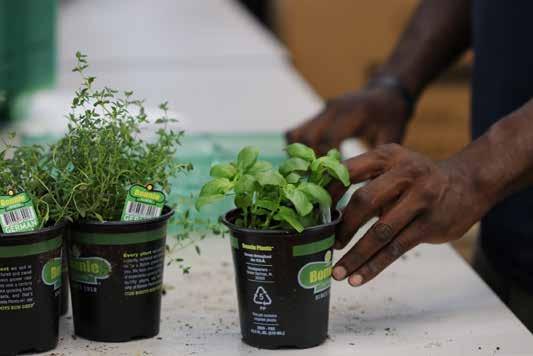
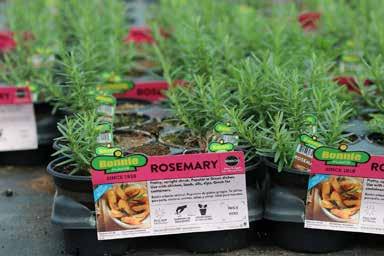

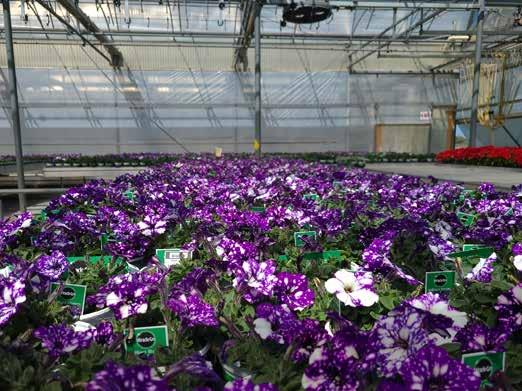




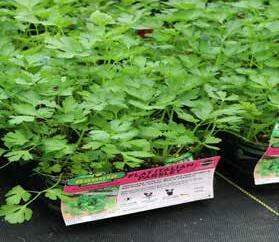
3 for $10 APRIL 4TH - 16TH AT PARTICIPATING CO-OP STORES 4.5” Pots & 6 packs ASSORTED VEGGIES, HERBS AND FLOWERS. SELECTIONS MAY VARY www.BonniePlants.com | www.Alafarm.com
PLANT S e SPRING
ARCHERY TIPS FOR TIPPIN’ TOMS
TOOLS AND TECHNIQUES
BY TODD AMENRUD
When calling turkeys, occasionally you’ll get a bird that comes to the call like he’s led on a string. However, turkey hunting isn’t always that easy, especially for us bowhunters. For an archer it doesn’t get much more challenging than putting a precise shot on a bird that is most likely moving and has a kill zone the size of your fist.

Sitting or kneeling and then getting away with the motion of drawing your bow is a different story than parking yourself comfortably against a big oak tree with your shotgun propped on your knee. I like to hunt turkeys with both, a bow and shotgun, but there
are a few tools and techniques that can make the challenge much easier for the archer than the same tried shotgun basics.
The type of set-up you’re planning on will influence how difficult it will be to get away with the motion of drawing your bow. Are you using a blind and decoys, will you have a buddy call the bird past you, or maybe you’re relying on natural cover, good camouflage and your hunter’s savvy?
A blind can be a huge asset. This way you’re concealed when you make the drawing motion. Overall, if I consider both archery and shotgun harvested birds,
OUTDOOR LOGIC WITH BIOLOGIC
34 Cooperative Farming News
Decoys are a valuable tool for the bowhunter. They take the attention off of you, they lure the birds in closer and they can be used as a yardage marker.
I’ve harvested more gobblers without using a blind. But when it comes to “just archery,” I feel a blind increases your odds for success significantly.
There are many companies that manufacture portable blinds that are light to carry and easy to set up. When hunting whitetails from a ground blind, you’d better have the blind “brushed-in” and well-camouflaged, or have it set out weeks in advance of the hunt, so the whitetails become accustomed to it. On the other hand, for turkeys it seems you can set up in the middle of a bald field and they will walk right up to it. If you don’t wish to carry around a portable “pop-up” style blind, you can also use natural materials to construct a blind or make an “L”-shaped structure with a piece of camo cloth or netting.
without are decoys. Where sometimes I’ll go without a blind, I never go without decoys. Decoys can accomplish a few tasks for you. They attract the bird(s) closer, draw the attention off the hunter, and a decoy can even be used as a yardage marker if needed.
Decoys can accomplish a few tasks for you. They attract the bird(s) closer, draw the attention off the hunter, and a decoy can even be used as a yardage marker if needed.
I almost always carry two hens and some type of a male turkey decoy – jake or gobbler. That male decoy, I feel is the key to bringing real gobblers in close. Nowadays there are numerous full-bodied, full-strut decoys that really work well. Some of the good ones you have to look twice yourself to tell that it’s a decoy.

Calling will likely be different for a bowhunter as well. You may use the same call arsenal as any other hunter to start the tom on his way to you, but once he gets close, you’d better have both your hands on your bow and be ready to draw. For just this reason, it’s a good idea to master a diaphragm or some type of mouth call.
The other tool I wouldn’t enter the turkey woods
Several decoy techniques will work. Before I started regularly using a blind, I used to try to lure the gobblers past me with the decoys, drawing my bow when they got behind a tree or when their fan obstructed their view. This can still be a great technique if you don’t want to lug around a blind and you want to stay mobile. It works especially well if you’re hunting with a friend – one tries to call the bird(s) past the other. This way the attention is directed toward the caller and where the decoys are. Obviously you need to know the direction the birds will be approaching and you’ll want to have some cover nearby so there will be some chance to draw your bow while their eyes are obstructed.
Another way was taught to me many years ago by an old bowhunter from Tennessee. A strutting decoy is the main focus of this set-up. Place your hen decoys how you normally would, but when you set up the male decoy, put it out about 10 steps, but make sure that decoy is facing you. Use a stick on either side of the decoy to make sure it doesn’t pivot and stays facing you. If you give them time, most often the gobbler will wind up in a face-to-face, full-strut confrontation with your male decoy. This will typically leave you faced with a “full strut fan” protecting your movement from their keen eyesight, which gives you an opportunity to draw your bow.
With this decoy set-up, it isn’t necessary to have a blind, but you must have great camouflage and you must stay perfectly still with your bow in your lap until you draw it. I really like Mossy Oak Obsession for the spring woods. With the turkeys’ unbelievable eyesight, Obsession gives great depth, so as long as I don’t move, I can go unnoticed. I like to sit with my butt on the ground; I can stay still for much longer this way than kneeling.
The key is to wait for your targeted gobbler to
April/May 2022 35
Many bowhunters feel a head shot is the way to go, especially if the bird is close. After all, their head is only slightly smaller than their vitals and if you miss, you don’t end up with a wounded bird and wasting a day trying to recover it.
(Photo Credit: John Hafner, National Wild Turkey Federation)
go full-strut, face-to-face to your decoy. Now pick up your bow and draw. Even if there are multiple birds and they see you, it usually takes about five to seven seconds for your targeted gobbler to come out of full-strut and figure out what’s going on. By then the arrow should be on its way.

With most blinds, set up should be easy; however, there are a few tips that will make it even easier. If you know where the birds are coming from, don’t place your decoys in between you and where they are. Place your decoys off to the side of your blind at a 45° to 90° angle. If you place the decoys directly in between you and the birds, the birds will be looking straight at you when they approach. Obviously, there’s the chance that even though you’re in a blind, they may catch movement or something about the blind they don’t like. Also, their tendency is to stop short and wait for your fake birds to join them. If you place your decoys off to your side, you still draw them close enough for a shot even if they don’t come all the way into the decoys.


Regardless of the archery tactic used, where do you shoot the bird? Many tell you “right up the rear” is a good shot. In all honesty, if you’re not worried about
ruining the beard or fan, it is a good shot choice – as long as you don’t ruin the meat. The other drawback is field dressing the bird will be a bit messier. However, I prefer to wait until the tom starts to turn at an angle. Now there are two choices - body or head. If they’re close enough, a head shot is the way to go. If you think about it, their head is only slightly smaller than their vitals…AND if you happen to miss, there’s no wounded bird. If you hit, nothing puts them down faster than a broadhead to their head. Some of the specialized hunting heads for turkeys are sporting cutting diameters of up to 4 inches! I’ve seen these decapitate a turkey…literally.
To me, the whole “essence” of turkey hunting is calling the gobblers into a set-up. Obviously, if that’s all it was, I would never take a gun or bow into the woods with me. So harvesting a bird is a goal, but not necessary for a positive outing. If you’ve never tried bowhunting for turkey, or maybe you’ve not had any luck yet, a blind and decoys are two tools that will help you seal the deal.

36 Cooperative Farming News
A blind can be one of the most important tools for a hunter. It helps bowhunters get away with the necessary motion of drawing their bow.
(Photo Credit: Tom Evans - NWTF.5o)
Either a head shot or an arrow to the vitals will put down a gobbler. The author arrowed this tom through the vitals with a fixed blade broadhead.
CULLMAN County #3687

47+/- AC - This is the perfect business opportunity for someone who loves the outdoors and has a green thumb! Haynes Plant Farm is a 47+/- acre tract with a 60,000 square foot nursery/greenhouse operation. The farm is currently operating as an active, income producing business. Haynes primary focus is vegetable plant production for established customers from all over AL,TN,MS, and GA. $484,900


Tallapoosa County #3292
210+/- AC - Once in a lifetime opportunity to purchase over 200 acres of undeveloped & unrestricted property on beautiful Lake Martin. Imagine waking up every morning with a waterfront view and having endless options of how to spend the day on your property. You could launch the boat and spend the day out on the lake fishing or joyriding. If you like to hunt, you could ease your way through the mature pine and hardwood bottoms in search of a trophy deer in the fall or a weary old gobbler in the spring. $1,495,000
Dallas County #3759
395+/- AC - The timber on the property was cut in 2020-2021, an would make a productive site for re-planting pines or other species for a future timberland investment. The property has a good site index for timber production. The property would also be set up to make a good recreational and hunting property. There are internal roads and trails that lead throughout the property. $600,400
covington County #3522
30+/- AC - Property consists primarily of row crop farmland currently planted in corn. This property has the potential to make an excellent homesite for someone wanting to live in the country, build a home, and have their own open land to grow crops/garden, raise cattle, or just to hunt. $110,000




butler County #3728
695+/- AC - This tract features two named creeks that join on the property. Pigeon Creek is the main water feature with Three Run Creek also flowing on the property. With over 400 acres of mature bottomland hardwood this tract is impressive from both a timber and wildlife perspective. $1,737,500
perry County #3516
172+/- AC - Properties along the Cahaba River are rarely available for purchase, and this tract has approximately 1/2 mile of frontage on what is our longest free-flowing river in the state. The property lies along the east side of the river. The timber on this property is a good mixture of 20–25-year-old pine plantations, 4-8 year old pine plantation, and upland and bottomland hardwoods.$346,400
cherokee County #3611
1472+/- AC - This is an extraordinarily rare opportunity to buy a large tract with long tern timber investment and recreational uses. There are numerous recreational opportunities on this property including deer hunting, turkey hunting, duck hunting in the duck swamp, ATV riding and more. The property has of 132+/- acres of hardwoods, 35.75+/- acres of natural pine, 90 acres of open productive land and 1126+/- of pine plantation in varying pre merch age classes planted. $2,174,150
lauderdale County #3488
343+/- AC - This tract features two creeks, a pond, mixed hardwoods, and roughly 90 acres of partially fenced pasture. Historically this land has been farmed and used for both cattle and hogs. This area is known for deer and turkey hunting and backs up to Lauderdale WMA, offering even more acreage for the new owner to hunt. $857,500
montgomery County #3144
420+/- AC - Greatly suited for the avid hunter and long term investor, this tract also features a 1-2 acre pond, food plots, internal roads and plenty of county road frontage that would make dividing this tract in the future very easy. This tract has a gated entrance and paved county road frontage on Gardner Road, Pisgah Road, and Smilie Road. $1,113,000
Chambers County #3746
96+/- AC - Located on County Road 83, across the county road from Chambers County Lake, this is a well-maintained home situated in the middle of it all. The property consists of approximately 60 acres of once thinned pine plantation that will keep growing into saw timber and pole quality timber, with the remaining balance of the acreage, consisting of beautiful, mature hardwood trees and open areas around the home and storage buildings.$599,000
our latest listings and more! www.selandgroup.com | 866-751-LAND SEARCH FOR OVER 800 MORE PROPERTIES ON OUR WEBSITE! The poultry farm market is STRONGER than ever. The PoultrySouth Team is selling farms all over the Southeast, and getting those farms closed out. We are glad to consult with you confidentially, FREE, and without obligation if you are interested in selling. MT. MORIAH FARM 9 House Broiler Farm in Clay County, AL SOLD ASHLEY FARM 4 House Broiler Farm in Lawrence County, AL SOLD LEARN MORE ABOUT OUR PROCESS AT WWW.POULTRYSOUTH.COM
RANDALL UPCHURCH PoultrySouth Co-Founder ROBERT KING PoultrySouth Co-Founder 67 FARMS SOLD IN THE LAST 2 YEARS 256-475-0490 psteam@poultrysouth.com !$
MEXICAN VENISON AND EGGS SKILLET BREAKFAST

Ingredients:
4 teaspoons olive oil
1 onion finely chopped
16-ounces lean ground grass-fed beef or venison
4 Tablespoons chipotle sauce
1 quart tomatoes chopped
3/4 cup milk
1 bunch cilantro roughly chopped, plus extra for serving
Kosher salt to taste
Freshly ground pepper
4 eggs
1 jalapeño chile thinly sliced
Sourdough bread cut thick
Ingredients:
In a deep skillet, heat oil over medium-high heat. Add the onions and a pinch of salt and cook, stirring often until soft, about 4 minutes. Increase the heat to high, add the ground meat and cook until done, about 5-8 minutes.
Meanwhile, place cut pieces of sourdough bread into the oven at 200 degrees. Add the chipotle sauce, tomatoes, milk, cilantro, salt and pepper to your skillet. Reduce the heat to medium and cook until slightly thickened.
Make four indentions into the skillet mixture by using the back of a spoon. Crack each egg into the indentions. Cover and cook for 5-7 minutes or until the eggs and meat are fully cooked. Place the sliced chile and remaining cilantro over the mixture. Add salt and pepper to taste.
Once toasted, remove the bread from the oven. Plate the bread and spread the mixture from the skillet over the bread. Serve immediately.
About Stacy Lyn Harris

Stacy Lyn Harris is a best-selling cookbook author, blogger, TV personality, public speaker, wife and mother of seven children. She currently lives in Pike Road, Alabama, with her husband Scott and their children. Stacy Lyn regularly appears on cable and broadcast television as a guest chef and sustainable living expert. Her critically-acclaimed “Harvest Cookbook” was published in 2017 and contains many of her family’s favorite recipes, along with stories from her life growing up in the Black Belt and tips she’s learned along the way.

38 Cooperative Farming News
A GUIDE TO OWNING FORESTLAND

PART TWO
BY BILLY RYE
Knowledge is the key to making the ownership of forestland a rewarding experience. In the last edition of the Cooperative Farming News, we discussed the importance of assessing what you have and determining what you want. In this article, we will discuss some of the most important aspects of planning and how to build a winning team.
KNOW HOW TO GET THERE
Benjamin Franklin said that “If you fail to plan, you are planning to fail.” Planning is essential if you are to realize the rewards of owning forestland. Whether it is for individual forest management practices or for your entire estate, you need a plan. A good plan will improve the utilization of your resourc-
April/May 2022 39
YOUR FOREST
FARMING
es, provide motivation and commitment, set professional performance standards, and allow for flexibility. There are at least three plans that you should have regarding your forestland.

Forest Management Plan. Regardless of your objectives, a forest management plan will provide direction for your efforts and resources which will increase your enjoyment of the property. Your management plan should be prepared by a Registered Forester with your best interests in mind. While there are many sources of free forest management advice, you will get more pertinent and practical information if you pay a full-time forestry consultant to prepare your plan. In general, the forestry consultant will listen to what you want, look at what you have, and prescribe a course on how to get there. The types and costs of management plans will vary, but you should recall that you normally get what you pay for.
Timber Harvesting Plan. I have seen many landowners work a lifetime to grow timber, only to blow it during the selling process. Timber sales should be coordinated by a well-written plan and marketed when the prices for the products present are good enough to warrant a sale. For a fee, a consulting forester can help make sure that the objectives of your timber sale are met by obtaining a higher price for your timber, protecting you and your property through
a written contract, and by providing you with overall peace of mind. A consulting forester can also provide valuable information on the tax implications of timber sales and reforestation specifications.
Estate Planning. Big or small, we all have an estate. Your estate is everything you own including your car, bank accounts, investments, real estate, life insurance, personal property, retirement accounts and forestland. You should work with a qualified CPA and an attorney to make sure that your belongings are distributed in the manner that you desire after you die. According to estateplanning. com, estate planning is more than just a strategy of minimizing the taxes upon your death, it is a plan to make sure your legacy is passed on to your loved ones. As with all plans, your estate plan should be reviewed and updated as your family and financial circumstances change. To give you and your loved ones the most peace of mind, you should begin your estate planning now.
KNOW WHOM TO CALL
Most Alabamians love college football, and we fully understand the different skill sets needed to make a winning team. The same is true for your forestland. If you are to win in the game of ownership, you need a successful team. Avoid “one stop shopping” when it comes to forming your team of professionals, as you will need those who specialize in your unique set of needs. Consider recruiting the following professionals to be a part of your team:
Consulting Forester. I recommend that you hire a Registered Forester whose primary work is providing consulting services to forest landowners for a fee. In

40 Cooperative Farming News
Consulting Forester Alex Boldog of Andalusia discusses the forest management plan that he prepared with the heirs of his client.
Billy Rye of Forest Management Specialists, Inc. in Florence (left) listens to a landowner as he describes his timber resources and what his objectives for the sale are.
Alabama, all foresters offering their services for a fee on property that they do not own must be Registered. Always ask for this credential when receiving advice from anyone who gives forest management recommendations for your property. I specifically recommend that you consider a Registered Forester who is a member of the Association of Consulting Foresters of America (ACF). Members of this organization must meet certain ethical and educational standards. The ACF ethical standard that most protects landowners, I believe, is the one that prohibits members from buying timber. They can only assist landowners with selling and thereby avoid a potential conflict of interest. While some consultants that are not members may choose to meet ACF standards, members are required to.
In Alabama, all foresters offering their services for a fee on property that they do not own must be Registered. Always ask for this credential when receiving advice from anyone who gives forest management recommendations for your property.
Surveyor. The Alabama Board of Licensure for Professional Engineers and Land Surveyors establishes requirements for licensed surveyors. While any licensed surveyor can conduct your work, I recommend that you use one who specializes in forest/recreational land. Their experience in interpreting deeds and knowing the section corners in remote areas makes them more adept at surveying forestland. Be sure to ask the surveyors that you interview if they offer a digital copy of your survey for future relocation of corners and lines.

Estate Attorney. You will not only need an attorney who is licensed by the Alabama Bar but who also specializes in estate planning to ensure that your estate is handled according to your will. An estate attorney is defined as an experienced and licensed law professional with a thorough understanding of the state and federal laws that affect how your estate will be inventoried, valued, dispersed, and taxed after your death (www.protective.com).
Accountant. You should employ a certified public accountant that has a good working knowledge of real estate, timber and estate taxes in Alabama. They should also be well acquainted with the information detailed on the National Timber Tax website (www. timbertax.org). Some of the most common timber tax topics include timber property classification, reforestation tax credit, amortization of manage-
ment expenses, and casualty loss. Timber revenue is eligible for Capital Gains treatment which is taxed at a lower rate than Ordinary Income. Understand that you will be responsible for paying taxes on the gain in value of the timber and your accountant will probably recommend that you have a Registered Forester establish your Tax Basis to gain credibility with the IRS. Real Estate Broker. Should you decide that it is in your best interest to sell the forestland, you should use a licensed real estate agent that specializes in timber/recreation land. While any real estate agent licensed in Alabama can list your property, those who specialize in forestland have more expertise in pricing, marketing, and selling your type of property than do those who primarily list residential or commercial property. Don’t forget that you may owe capital gains tax if you sell the property for more than the assessed value at the time of acquisition.
April/May 2022 41
Evan Horne of the Civil Group, LLC in Florence calibrates his hyper accurate GPS in preparation for a survey.
Landowner Advocacy. Webster defines an advocate as “one who supports or promotes the interests of a cause or group.” While there are many landowner advocacy groups that operate in Alabama, there are at least two that you need to be aware of, the Alabama Forest Owners Association (AFOA) and the Alabama Forestry Association (AFA). Formed in 1981, the AFOA has grown to more than 8,000 members. Their mission is to serve as an advocate for forest owners and to keep its members well-informed on all things related to forest ownership. AFOA is supported by membership and service fees from thousands of forest owners and, unlike most other forest landowner associations, remains independent of government agencies and the forest products manufacturing industries. The AFA was formed in 1949 and has as its mission to maintain a favorable political, regulatory, and legal environment for landowners to grow trees and forest business owners to manage their operations profitably and sustainably. AFA’s vision is to represent their members as the Voice of Forestry in Alabama in state and national affairs, and support sustainable forestry practices and programs. It is my opinion that both organizations provide benefits that far outweigh their membership dues.
Free advice. There are several sources of free help available to forest landowners in Alabama. The Alabama Forestry Commission can provide information for individual forest management practices

while the Alabama Wildlife and Freshwater Fisheries Division can provide information on the management of most species of wildlife. The U.S. Forest Service and the U.S. Fish & Wildlife Service also aid landowners, usually by providing funding through the existing state agencies. The U.S. Department of Agriculture has several cost-share or incentives programs available in most counties of Alabama. Check with your local Farm Service Agency or Natural Resource Conservation Service for program eligibility, requirements, and sign-up dates.
Your forestland cannot only be rewarding financially, but it can also be a great source of enjoyment for you and your loved ones. By knowing what you have, what you want, how to get there, and whom to call, you will turn this investment into a legacy to share with future generations.
A special thanks to the following for reviewing this article for accuracy. Joseph Propst, Esquire; Whitmire, House, and Propst, LLP; Decatur, Alabama.
Myra Roberts, CPA, CVA, & AEP®; BMSS Advisors and CPAs; Birmingham, Alabama. Jay Johnson, Instructor at Johnson Real Estate and Broker at Exit Realty; Florence, Alabama.

42 Cooperative Farming News
Myra Roberts and Donny Donald of BMSS Advisors and CPAs in Birmingham review a plan with their client that will help her avoid paying unnecessary taxes and ensure that her legacy is passed on to her loved ones.
Ed Travis of Travis Timberlands in Mobile uses his marketing expertise and knowledge of the resource to provide value-added benefits to his customers.
Zone Protects Scented, Unscented and Realtree Invisible Hunter Insect Repellent are great products for those who seek DEET-free products. 12-hr proven protection against mosquitoes, ticks, flies, fleas, chiggers, gnats and no-seeums.






• Picaridin-based (derived from the black pepper plant).
• Safe for adults, children, pregnant women and even pets.

• Non-Oily, non-greasy, non-staining and won't damage clothing or gear.

April/May 2022 43 MID STATE STOCKYARDS LLP. “Serving the Southeast since our beginning in 2003” 8415 State Highway 97 South, Letohatchee, AL 36047 - Interstate 65 Exit 151 Sale Day: Tuesdays 10:00 a.m. 1-877-334-5229 | 334-227-8000 www.midstatestockyards.com Clanton205-288-6298 Drop-Off Locations: Wetumpka334-313-3695 East AL706-577-1900 Covington Co.334-488-0934 SW AL251-989-3992 PARTNERS: Billy Younkin 334-313-3542 Scott Garrett 334-303-1488 Dick Farrior 334-399-0170 TriGreenEquipment.com Shop our availability at TriGreenEquipment.com Upgrade your equipment to what’s Jeff Register Building & Truss RegisterBarns.com 40’ x 60’ x 12’ - Installed Roof only, closed gables - $8,300 Roof only, open gables - $7,500 30’ x 40’ x 10’ - Installed Roof Only, open gables - $4,500 *Prices do not include tax and delivery* Office - 228-678-0971 Cell - 228-234-9115 or 228-234-7241 Jregister@registermetals.com Locations: 2811 26th Ave. Gulfport MS and Highland Home, AL
SOMETHING’S FISHY
 BY WALT MERRELL
BY WALT MERRELL
“I’ll be home shortly,” I told Hannah, as I hung up the phone and walked into the courtroom. “I’m sorry, Judge,” I offered an apology for being tardy. He nodded his head, but his eyebrows remained furled… he expected some measure of an explanation. “Our freezer went out, and my wife was calling to let me know.” He relaxed his expression and then offered a few conciliatory remarks. We spent the next hour taking testimony and presenting arguments about various
pre-trial legal issues on a murder case. When I walked out of the stuffy confines of the South Alabama courtroom, I went straight to my truck. Stepping out into the fresh air of that fall afternoon, I could feel the rejuvenation of the crisp, cool temperature on my skin, and the bright sun bounced off the western horizon as it ran from the eastward moon. I climbed into the cab of my truck and threw my files and my suit coat into the passenger seat. That three-quarter-
SHEPHERDING OUTDOORS
ton Dodge diesel growled to life, and, almost immediately, I could feel the stress of the job leave me… as if the truck itself was fueled by the tensions of the day. Rumbling down the road towards our small Loango, Alabama farm, I cherished the opportunity to leave work early… but dreaded the task that lay before me. Driving home, the roar of the mud tires and the rumble of the “needs to be repaved” road lulled me into thoughts of yesterday, bathed in anticipation of things to come.
My mind drifted…
We lived just an hour and a half or so from the Gulf of Mexico. I grew up in Baldwin County, and as a young buck, I spent a considerable amount of time in a 16-foot, wooden Stauter-Built (pronounced Stow-ter) boat, roaming the grass bed of Mobile Bay. That 35 horsepower Johnson never went anywhere fast, but it was always reliable… but as I aged, my childhood sufficiencies gave way to adult-like expectations, and that 35 Johnson wasn’t “enough.” For shame, too… that was a great boat. Jones-itis… that is the “itis” affliction of keeping up with the Joneses… took hold in my thirties, and I soon found myself the proud owner of a brand new 22-foot bay boat with a 200 horsepower Yamaha motor. For comparison’s sake, imagine the Stauter built as a mule and the bay boat as a racehorse.
But don’t ever forget… life is, oftentimes, a turtle’s race.
Within a week or two of buying this new boat, Hannah, Bay, Cape and myself drove to Mobile and set out to catch Redfish and Speckled Trout. We picked up my mother and her husband in Fairhope, and launched at the public ramp across at the end of Pier Street. The motor purred as the boat comfortably slid across the light chop of Mobile Bay. The salt tickled my nose, and the spray of the occasional bow break glistened my face. Middle Bay Lighthouse sat off the starboard bow as we cruised across the Bay, eager to fish the rock jetties around Gaillard Island. A bird sanctuary, it is known to locals by another name… not fit to print… think thousands of birds all standing in the same place day in and day out. Slowing to a drift near the northeast corner of the triangular shaped island, we found refuge on the leeward… calmer water that was a result of the island itself blocking the south wind. Just ahead, a school of juvenile mullet huddled close to the rocks, hoping to avoid detection from larger predators trolling just out of sight. In the deeper water, they made the perfect bait and in the shallows, they made the perfect target. One swing of the cast net landed us 11 healthy bite-sized baits for the Bull Red and Gator Trout we hoped to catch.
The small mullet flopped and flipped in the bottom of the live well. Their tail wags sounded like machine gun fire as they “flap, flap, flapp-ed” against the bottom of the live well basin. But slowly, the water filled in and their gasping gills, thirsty for air from the oxygen-rich waters, calmed. Soon enough, the soon-to-be hook holders settled in comfortably to their new environment. And though doom would be their fate… they seemed quite content that no larger predator lurked in the outskirts, waiting to gobble them up.
But the South wind grew stiffer, and, within an hour, the boat pitched and rolled uncomfortably. No fish and a lot of wind will shorten most every fishing trip, so we turned east and motored back to the launch. The inaugural fishing trip for my new boat wasn’t much of a success… seems big motors and fancy rigs don’t do much to overcome poor fishing skills and foul weather.
A week passed, and the boat sat idle in the yard. A heavy canvas cover protected it from rain and falling leaves, but that cover was burdensome, to say the least. Hopping out of my truck after a

April/May 2022 45
long day at the office, I pulled at the edges of the boat cover as I passed near… ensuring that the lines were all still taut. After my second, still in stride, tug at the cover, my nose caught a distinct odor. An odor I knew to be a sign of something ominous… that familiar smell of death and rotting decay. I stopped dead in my tracks… one hand still clutching the cover. Motionless, I attempted to get a more discerning sniff, and that’s when I heard a noticeable buzz… a droning sound, if you will… coming from underneath the cover of the boat.
I loosened one strap, and then another… the two of them side by side, and just far enough apart for a grown man to slide between. Lifting the cover for an inspection, the putrid smell of rotten fish overwhelmed me. I dryheaved a few times as I recoiled away from the boat. Saliva filled my mouth as I spat it away, trying desperately to rid my taste buds of the horrific encounter… and then it hit me: “I left those mullet in the live well.”
tion that I was nearly home. The big diesel slowed to a near crawl as I waited for passing traffic so I could turn into the driveway… fully aware that my memories of rotten mullet brought on my realization that several hundred pounds of deer meat, beef, pork, fish and all sorts of vegetables, now lay in a rotten lump at the bottom of our freezer.
Earlier that day, Hannah told me enough to know that the situation was not good. Given the fact that when she cracked the lid, the smell nearly knocked her off the back porch… and that all she clearly saw in that brief moment, was larva… I knew enough to know that, based on her description, the mullet from the live well might as well have been in that chest freezer.
She was running. She was nearly naked. A line of clothes dotted the pasture in a straight line behind her. And… she was running straight to me.
I’m fairly confident that the color left my face as I realized the droning buzz I heard was thousands of flies orbiting around under that boat cover. And soon enough, as I took one deep breath and reached into the live well, the contents of my stomach left as well.
“My Stauter-Bilt didn’t have a live well,” I thought to myself as I pulled the last hunk of rotten pudding from the live well. Seems the turtle was winning the race…
My recollections were interrupted by the realiza-
“I am going to see if I can pick it up with the tractor,” Hannah told me earlier on the phone. “I am just going to haul it out into the middle of the pasture and leave it. We can clean it out, and leave the food for the buzzards and the coyotes.” It seemed a reasonable enough plan to me, though my court obligations kept me from discussing the details with her any further.
Coming into the driveway, my eyes drifted out into the pasture, where I spied that big white, chest freezer, semi-cocked on an angle like a ship listing as it sinks. The lid was open. A few items littered the grass around the freezer… the likes of which I couldn’t entirely discern… and there was no immediate sign of Hannah. Pulling past the house to my normal parking spot next to the playhouse, motion caught my eye. Turning to my right, looking

46 Cooperative Farming News
through the glass of the passenger door, I saw my beloved bride running straight towards me.
She was running. She was nearly naked. A line of clothes dotted the pasture in a straight line behind her. And… she was running straight to me.
Now, Hannah is a free spirit. And, of course, I… being the 30-something-year-old rabbit with Jonesitis that I was… quickly deduced that freezer duty was going to have to wait. Because… there were clearly other, more important details that needed to be tended to.
Flinging her bra to the wind, she never broke stride… I quickly shed my tie and put all of my files back on the driver’s seat of the truck. “What passion this woman has,” I thought to myself, as I rounded the front of the truck to meet her. Holding up my arms and steadying myself to catch her… I knew this would surely be one of those sappy-love-embrace moments like you see in every Julia Roberts movie. Just as I turned to catch her, she veered slightly and ran right past me. “The Streak” was running so fast that the blow-by curled my hair as she passed.
“Fiiirrreee aaannntttttsssss…” She screamed as she went straight to the water hose in the back yard. I was still so caught up in the hopeful romanticism of it all that I simply stood there like an
idiot… scratching my head, trying to figure out how I so terribly misunderstood the situation.
An hour passed, and she was fully dressed. We sat on the back porch in a swing, staring at the stillfull freezer in the pasture. Two deer crossed the field behind that big white box, cocked at one end by the kickstand of a fire ant bed that it was sitting on. I got up and pulled open the screen door to the kitchen…


“Where are you going?” she asked.
“Inside to unplug the refrigerator,” I responded. She cocked her head slightly to one side and stuck both her feet to the porch floor. The swing stopped abruptly. I knew the question was “why” even though she never uttered a word.
Before she could ask, I winked at her and said, “Cause I like it when I come home and find a naked woman running around in the pasture!”
Walt Merrell writes about life, family and faith. An avid hunter and outdoorsman, he enjoys time “in the woods or on the water” with his wife Hannah, and their three girls, Bay, Cape and Banks. They also manage an outdoors-based ministry called Shepherding Outdoors. Follow their adventures on Facebook, Instagram and YouTube at Shepherding Outdoors. You can email him at shepherdingoutdoors@gmail.com.
April/May 2022 47
www.bigiron.com (800) 937-3558 THE MARKET IS HOT JODY LENDERMAN | DISTRICT MANAGER - ALABAMA 256-684-1236 | jody.lenderman@bigiron.com TRANSPARENCY QUALITY LISTINGS UNRESERVED LIEN FREE NO BUYER FEES TARGETED MARKETING LIST YOUR EQUIPMENT WITH BIGIRON
WHERE HISTORY MEETS OPPORTUNITY
BY JESSIE SHOOK
AFC President and Chief Executive Officer Rivers Myres took the stage to deliver his ninth President’s Report at the historic 85th Annual Membership Meeting. Myres began by thanking his wife, Mary Tucker, who was in the audience. He recognized all of the spouses and partners whose support contributes to the success of each person at AFC.

On AFC’s 85th year, Myres took the opportunity to reflect on where the company began and where it is today. “At the time of our founding, AFC had 11 members and $10,340 of equity,” Myres said. “Today, we have 31 members and $390 million in equity. As a whole, AFC does business in 48 states and employs thousands of people.”
Myres highlighted the changes that have taken place within the company and over AFC’s 85-year history. He made the point that even though the world and AFC are more complex, our core values remain the same. “AFC’s leadership thinks about these values every day,” Myres emphasized. “They are the guiding principles for every decision we make.”
Myres was pleased to report that for the 2021 fiscal year, AFC returned $22.5 million to AFC’s membership in patronage and equity retirement. Not only that, but since 2014 AFC has returned over $97 million to the membership in the form of equity retirement, patronage, loyalty rebates and insurance incentives. “AFC’s membership today is healthier than it ever has been,” Myres said.

48 Cooperative Farming News
85th Annual Membership Meeting
ALABAMA FARMERS COOPERATIVE’S 85TH ANNUAL MEMBERSHIP MEETING
Photo Credit: Studio Panache
Photo Credit: Studio Panache
“I appreciate each of our Co-op managers for the hard work that contributed to this success.”
Following his report, Myres presented the 2021 President’s Award to 25 Cooperative General Managers who finished the year with positive local earnings and net margin to sales equal to or greater than 1.5%.

The retirement of James Fudge brought a new face to Management Services as Andrew Dempsey assumed that role as the new Vice President. John Gamble retired as Vice President of AFC Grain Division after 43 years of service, and AFC welcomed Bart Payne as the new Vice President of Grain.
AFC’s Chief Financial Officer, Thomas Hallin, began his report by highlighting the events that made 2021 a transformational year for the company. AFC formed a new farm supply partnership, Faithway Alliance, with Tennessee Farmers Cooperative (TFC); formed a new agronomy joint venture, GreenPoint Ag Holdings (GPAH), with TFC and WinField United; and completed the sale of 50% of AFC’s ownership in Bonnie Plants to Scotts Miracle-Gro. These transactions had a profound impact on AFC and its membership. “Our financial condition is truly remarkable,” Hallin added.
Each division and joint venture confronted challenges, faced changes and obtained victories over the course of the year. Each are looking toward the future to continued success. Faithway Alliance faced growing pains and dealt with logistical and operational challenges during its first year. Despite this, Faithway completed the year with sales of $158 million and net income of $2.6 million. Faithway also announced that Mike Elsea had become the new CEO after Tommy Dailey’s retirement.
AFC’s 25% share of GPAH’s earnings was more than double AFC’s prior year share of earnings from Agri-AFC, in which it held a 50% interest. GPAH’s first year produced sales of $1.3 billion and net income of $58.7 million. GPAH is now the seventh largest retail economy company in the United States.
Bonnie Plants sustained 2020’s historic growth through 2021. Although experiencing a slight dip in sales, Bonnie was able to retain 80% of the new business seen in 2020. Bonnie also broke ground on its new headquarters in Opelika, Alabama. This move will further strengthen Bonnie’s relationship with Auburn University.
AFC Feed, AFC’s joint venture with Purina Animal Nutrition, is working hard to bring all feed manufacturing capabilities online, including the addition of a new warehouse, storage and blending facility on AFC’s Decatur campus. AFC Feed is positioned for growth and strong results in the coming year.
Following the business meeting, AFC’s Board Chairman, Ben Haynes, spoke of the positive working relationships among the Board of Directors and the legacy of servant leadership inherited from those that came before. “They have taught the rest of us the value of camaraderie and friendship, of being thoughtful and deliberate and above all, of being patient.” Chairman Haynes said.
The growth of AFC is attributable to years of service by prior directors and must be sustained with the continued work and diligence of its current and future leaders. “Eighty-five years is a historic milestone,” said Haynes. “There is not much in this world that lasts for 85 years anymore, and it is a privilege to be part of an organization like AFC that has stood the test of time.”
Following in the spirit of service, AFC was honored to present a donation to Big Oak Ranch in the amount of $5.000. With matching donations from GreenPoint Ag, Bonnie Plants, AFC Feed and CoBank, Big Oak Ranch received a total of $25,000 following the annual meeting. Just like AFC’s efforts to serve and safeguard Alabama’s agricultural community, Big Oak Ranch provides a safe haven for at-risk children to provide an opportunity for a future they might not otherwise achieve.

April/May 2022 49
Rivers Myres presented the 2021 President’s Award to 25 Cooperative General Managers. (Photo Credit Studio Panache)
Brad Benson, AFC Vice President & Corporate Controller, presented a $25,000 check to Kyle Cantrell, Big Oak Ranch Director of Operations.
(Photo Credit: Studio Panache)
OPENING SESSION KEYNOTE SPEAKER
DR. DELATORRO MCNEAL
BY JESSIE SHOOK
Dr. Delatorro McNeal opened the 85th Annual Membership Meeting in Montgomery, Alabama with an energetic and inspiring message. With his infectious laugh, he began his presentation by having the audience stand and chant “I feel good,” loudly, in the packed auditorium.

Dr. McNeal is an internationally renowned Peak Performance Expert. The Tampa, Florida, native and father of two daughters specializes in powerful, interactive experiences where he teaches business professionals to reach their peak performance within their company with psychology and methodology.
Dr. McNeal described his presentation as a roller coaster ride. “We are going to have a lot of highs and lows, ins and outs over the next hour,” he said. “Here is my promise to you: if you let me, I will change your life.”
During Dr. McNeal’s presentation, partic-
ipants learned how to develop the emotional muscle to strive for peak performance daily. They identified the best peak states to put themselves in to win consistently and align actions and habits with the attributes of top performers. They learned to think creatively about how to improve their performance, change their attitudes toward work and increase passion, while also increasing their commitment to personal excellence and learning to lead within their organization with a greater sense of purpose and certainty.
Dr. McNeal’s presentation was interactive from the start. He asked everyone in the audience to stand up and dance. “Did you know that according to neuroscience, when you dance, you are literally doing brain surgery on yourself,” he said. “Your brain literally releases four happy chemicals inside your head every time you dance.”
50 Cooperative Farming News
85th Annual Membership Meeting
Photo Credit: Studio Panache
WILL YOU BE BETTER TODAY THAN YOU WERE YESTERDAY? WILL YOU MAKE A SIMPLE DAILY DECISION TO BETTER YOUR BEST?
Dr. Delatorro Mcneal
BEING THE BEST
“You will never be able to out earn your own self-concept.” –
Brian Tracy
After everyone in the audience stood up and did their jig, Dr. McNeal began explaining performance beyond goals – how to take your best and top it. He stated how important it is to know that you are the best and we are the best in our industry.

This goes hand-in-hand with the belief that your best can be bettered each day and that small changes and improvements compound our growth over time. “Every single day life gives us one open invitation,” Dr. McNeal said. “Will you be better today than you were yesterday?”
COMMITMENT TO CHANGE
“Either proactively lead change or reactively be changed by change.”
The first peak performance idea is the commitment to change. With how much the world is changing every day, Dr. McNeal stressed the importance of “jumping on the change train.” You cannot stand in the way of change; you will get run over. You cannot let change pass you by; you will be left behind. Dr. McNeal gave the example of Blockbuster. While everyone has fond memories of renting movies from Blockbuster, when change knocked at the door, they let it pass them by. Now, Blockbuster doesn’t even exist.
ATTITUDE
“The lion doesn’t allow its limitations to keep it from being king. He is king because he believes.”
Attitude is another key component to the three peak performance ideas. Dr. McNeal gave the example of the lion. While the lion is not the biggest, tallest, smartest or fastest animal in the jungle, he is still known as the king – all because of the attitude he exudes.
Attitude can be changed by making mindset shifts, such as focusing on excellence versus perfection. Instead of focusing on perfection and how things appear, focus on the reason for the task and the results needed for it to be successful. Other mindset shifts can be made by taking an obligation and turning it into opportunity. “Instead of saying ‘I have to,’ say ‘I get to…’” Dr. McNeal explained. “’This is happening to me,’ to ‘this is happening for me.’”
RESILIENCE
“Life only tackles the person with the football –value what you are carrying.”
Resilience is the process of adapting well in the face of adversity. In this segment, Dr. McNeal referenced his mother, Olivia. She always told him “You can either be the racquetball or the egg. While the egg will break when it is dropped, the racquetball will bounce back. It may not always look pretty in the bounce back, but it comes out on the other side.”
Resilience gives you the power to overcome difficulties. Make shifts from being the victim to being the victor, turning failure into fertilizer, and changing “I’m stupid” to “I’m learning.” Just like with your attitude shifts, these will make you more resilient in overcoming challenges.”
LIVE MORE
Dr. McNeal ended by reminding the audience of the importance of having fun in life. “I’m not the motivational speaker telling you to work harder, you are already doing that,” he said. “I’m gonna tell you to live more, have more fun and enjoy the journey that you are on.”
The advice of Dr. McNeal was repeated throughout the remainder of the meeting, proving his impact on the audience. Change is a constant in agriculture every single day and Alabama Farmers Cooperative will be a part of that change, not left behind.
For more information about Dr. McNeal and his resources visit his website: www.delatorro.com.
April/May 2022 51
”
Photo Credit: Studio Panache
E.P. GARRETT MANAGER OF THE YEAR AWARD
DANIEL SALTER
BY JESSIE SHOOK
The recipient of the 2021 E.P. Garrett Manager of the Year Award, Daniel Salter, began his journey with Alabama Farmers Cooperative and Quality Cooperative, Inc. with a phone call from past General Manager and 2016 Manager of the Year, Ryan Williams. Salter was assistant manager at an auto shop down the road from the Co-op. After Williams’ persistence, Salter decided to consider the opportunity. “The last time he called it kinda just struck a nerve and I felt like I needed to hear him out,” Salter said. “I started two weeks later.”


Salter had been in retail most of his life with an agriculture background which made the transition seamless. He was assistant manager for three years before becoming General Manager of Quality Co-op and Salter said it fit like a glove right from the beginning. He knew he made the right choice. “It’s all about the people,” Salter added. “It’s not always the name on the side of the
building, even though AFC has a very reputable name – it’s the people that you work with.”
When asked why he enjoys working at the Co-op, Salter reiterated the most important thing to him – people. “I enjoy what I do because I get to work with so many different people,” Salter said. “While we are a rural store, we are under the umbrella of a large company that has the same values and ideals that I do. I don’t think a person should dread coming to work or dislike what they do – I couldn’t imagine liking anything else better.”
Surprised wasn’t the word Salter used when his name was announced as Manager of the Year. “I was actually kinda shocked,” Salter said. “I knew that our store numbers were really good but you never know. I’ve never needed an award to validate what we do but it certainly tells us that we are on the right track.”
52 Cooperative Farming News
85th Annual Membership Meeting
Photo Credit: Studio Panache
Photo Credit: Studio Panache
When Salter accepted his award, he was greeted by his family. His son, Elijah Daniel (4), joined him on stage, making this moment even more special. “That’s what it’s all about,” Salter said. “He loves it. He always tells me he’s going to be a Co-op man and working for a company that is very accepting of families means a lot. Just like inviting my whole family to see me accept this award … what company does that?”
at the forefront. “I’m really big on customer service –if we can’t do anything else right, we can at least ace customer service,” he added.
Family is as important to Salter as it is to AFC. He described the importance of having a supportive family at home and how it meant the world to him to have them present to see him accept his award.

Family is as important to Salter as it is to AFC. He described the importance of having a supportive family at home. “They live this every day, just like I do and it’s one thing to win something, it’s a totally different feeling when someone is there to see you accept it,” Salter added.
Salter said his success at the Co-op comes from staying humble and putting his customers and employees first. “My belief is that I don’t have all the answers and I have a willingness to listen to others, to customers and to the people I work with,” he said. “I am a people person first and foremost, I try to make the Co-op a very good atmosphere for the employees because I understand that the employees are the most important commodities that we have.”
Customer service is also something Salter keeps
Salter also believes that the leadership throughout AFC contributed to his growth and ability to win this award. “I think what contributed to me winning this award was AFC having the correct leadership,” Salter said. “Having the right people in place to navigate me through the learning process and once again, I don’t have all the answers, but some people do, and you’ve got to be willing to listen to those people,” said Salter.
Salter expressed how all the right people have to be in place at every level of this business to have success. “’The people that actually contribute to the award a lot of times never get recognized and it’s not just me or the people that work at Quality Co-op,” Salter said. “It’s everybody that answers the phone when I call, the people that I email when I need product, the people that make sure I get that product and don’t lose a sale – it’s everything working together to make that happen. Everyone should take pride in any manager winning because they certainly didn’t do it on their own.”
April/May 2022 53
Daniel Salter was surprised when his whole family was there to watch him receive the E.P. Garrett Manager of the Year Award. (Photo Credit: Studio Panache)
SPEAKER
BRETT BRUGGEMAN
BY JESSIE SHOOK
As President and Chief Executive Officer
Rivers Myres introduced Brett Bruggeman at the 85th Annual Membership Meeting, he described Bruggeman as “authentic” and “a man of his word.” “When he tells you something, you can count on it. He’s going to do everything possible to make it happen,” Myres said.
Brett Bruggeman is the President of WinField United and Executive Vice President of Land O’Lakes, Inc. His role focuses on delivering data-backed, insight-driven agronomics, operational excellence and sustainable solutions to help agricultural retailers meet farmers’ needs. Bruggeman began his career with Land O’Lakes, Inc. in 2015 with the merger of Land O’Lakes and United Suppliers seed and crop protection products businesses, which is known today as WinField United.

Bruggeman explained the importance of AFC’s Annual Membership Meeting and how having the leadership and membership together was a special event and an opportunity to show the commitment everyone has for this industry. “The reality is, there are some opportunities or hurdles, however you want to look at it,” Bruggeman said. “And when you hear the commitment of everyone, it’s a pretty big deal.”
Bruggeman sees nothing but opportunities. Knowing the concern for the current market, he described what is happening and what we are going to do. “It’s probably the biggest opportunity, at least in my 30-plus years, that I think we have as a system to take advantage of,” he added. “You have something special, and we need to make sure we keep pushing.”
WHAT’S HAPPENING IN THE MARKET
While some may say that the market has always been ever-changing, Bruggeman wants everyone to stop and think about the volume of change and the rate of change. In less than 24 months, 20% of urea and 20% of MAP/DAP have been cut off; there are four new CEOs with our competition, five new leads with manufacturers and $30 billion invested in new ag technology. “This is a fast train, and it’s not to underestimate what we can do or not,” Bruggeman said. “It’s to get your mindset that there is always change but it’s probably at the highest
54 Cooperative Farming News
85th Annual Membership Meeting
BREAKFAST KEYNOTE
Photo Credit: Jessie Shook
volume and highest speed that we’ve ever felt.”
Bruggeman stated that many are blaming supply chain problems on COVID-19, but supply issues started back in 2016 with China’s president. He began implementing strict environmental standards which led to manufacturing plants shutting down or relocating causing supply disruptions.
Next is inventory – in 2017 inventory levels were at 130%. “All the different manufacturers were coming together,” Bruggeman said. “Everyone was producing, and the market was shrinking, the inventory was growing. Since then, our working inventory is not 130%, it is closer to 25%.”
In 2018, tariffs were added to existing duties on imports into the U.S. This 15-25% increase in tariffs caused fewer products to come from China. This was followed by COVID-19 in 2020 and port infrastructure issues.
Weather caused supply issues in Texas in 2021 along with hurricanes. “Also in 2021, North America is no longer the most profitable place for manufacturers to sell their product, it’s better in Brazil,” Bruggeman added.
ness decisions. “The monthly market intel is shared with our field sales teams and is available to your business to help aid in inventory positions during both stable and volatile market swings,” Bruggeman said. Advances also come in the form of product innovation. This includes synthetic AI, biologics, combination AI and bio, and advanced genetics. Management changes in technology include digital and ag technology, AI and automation, ecosystem service and outcome-based markets.
Product substitution is an additional consideration. According to Bruggeman, there is plenty of product. It may just not be the same brand or SKU; but, it still does the same job. “There most likely will not be enough for re-spray,” Bruggeman said. “Get the right stuff down the first time.”
Bruggeman also emphasized that now is the time to focus on sustainability. Carbon dioxide levels have never been this high in human history and increase in demand has spurred investment in new carbon programs.
This also leads to crop protection issues. The product supply issues experienced in 2021 will be the same in 2022. Packaging issues, transportation delays and Gulf weather events caused significant delays in 2021. WinField United reported 187 vended brands as stocked out, while also experiencing 14 force majeure delays on raw ingredients.
WHAT IS WINFIELD UNITED DOING?
While 2021 may have been full of challenges, Bruggeman explained it was still a great business year for many. Support in these challenging times comes from focusing on optimizing manufacturing locations, innovation of technology, product substitution, reshaping our supply chain and focusing on sustainability.
By optimizing manufacturing locations, WinField United brings a new value proposition by being able to make products themselves. Logistics is a big deal and having the footprint brings more capabilities.
WinField United is also using technology, including monthly market intel updates. This empowers WinField United and its owners to make better busi-
For the betterment of the entire system, WinField United has a plan in place to improve the supply chain. That includes removing steps, forecasting demand, visibility of inventory and structured deliveries. By streamlining the process there will be more direct ship, pick up and structured delivery in the form of reliable, twice-weekly delivery in-season. They will utilize Evolve (digital order management system) which will help forecast demand while also allowing visibility of inventory.
Bruggeman also emphasized that now is the time to focus on sustainability. Carbon dioxide levels have never been this high in human history and increase in demand has spurred investment in new carbon programs.
The WinField United system is uniquely positioned to win with its four pillars. First, retail reach – 4,000 salespeople and local farmgate relationships. Second, market access – infrastructure and competence. Third, science – innovation and research. Lastly, Land O’Lakes brand – known brands open doors with consumer packaged goods.
Just like what we hear from AFC’s very own Rivers Myres, “Watch Us Win Together,” WinField United has set up a system that is positioned to win. “While many players have jumped into the space – no one can bring the context, assets and resources to the challenge like our system,” Bruggeman said. “We not only have the leading agronomic platform, but also the infrastructure to deliver on market needs.”
April/May 2022 55
A CREATIVE EXPERIENCE
Creativity was blooming at AFC’s 85th Annual Membership Meeting. The guest program was a creative experience with Jess Margeson from Frou Frou Floral Design. Frou Frou creates beautiful floral arrangements for a variety of occasions – from weddings and corporate events to bridal showers and birthday and holiday parties. Jess Margeson founded Frou Frou after she moved to the Auburn/Opelika area. Jess’ work has been featured in Southern Weddings, East Alabama Living and Southern Living.
During the guest program, participants created beautiful centerpieces for the dinner tables at AFC’s Awards Banquet. This added a beautiful and personal touch and participants were able to take their floral arrangements home following dinner.
 ENTERTAINMENT BY SHELBY DARRALL
ENTERTAINMENT BY SHELBY DARRALL
The entertainment for AFC’s 85th Annual Membership Meeting was rising country artist Shelby Darrall. The California native grew up with a love of music that was inspired by her father, Chuck Darrall, and his band, SilverCreek. Darrell grew up performing in the tasting rooms of wineries in Napa Valley. She moved to Nashville to pursue her musical dreams and quickly gained respect in the Nashville songwriting community. She has collaborated with artists such as Jake Owen, Larry Fleet and Josh Kerr, and recently opened for Little Big Town.

56 Cooperative Farming News
85th Annual Membership Meeting
GUEST PROGRAM


NOW AVAILABLE cookbook available online and at participating co-op stores $25.00
HUBERT FAMILY

TAKING A CURVEBALL AND TURNING IT INTO A HOME RUN
BY JESSIE SHOOK
58 Cooperative Farming News
FARMS
Seth Hubert reminisces of his childhood on a farm fondly. He remembers how his dad would come to career day at his school and all the kids would be in awe of his father, the farmer. “I thought it was the coolest thing in the world,” said Seth Hubert, owner of Hubert Family Farms. “I never thought I would do anything different, but life throws you curveballs and when dad died, our whole lifestyle changed.”
In 2003, Seth’s father, Billy Wade Hubert, passed away from a massive heart attack. After his death,
the farm operation ceased. Equipment was sold and rented land was let go. “We farmed about 2,000 acres when my dad passed away,” Seth said. “I was only 12 and my brother was 18. This was all we knew and when dad died, I felt like I didn’t have that opportunity anymore.”
With the dream of being a farmer in mind, Seth began to rebuild his family farm in 2016. The Hubert Farms original homeplace was bought in 1917 and is still a part of the land Seth farms today. “I started out with just a tractor and a planter and had to hire the rest out,” Seth said. “Each year, I kept trying to do a little more until I only needed help with harvesting.”
Seth was working a full-time job and farming on the side. He began to realize that he would have to do something different if he wanted to farm full
 (L to R) Addie, Kaylee, Atlas and Seth Hubert.
(L to R) Addie, Kaylee, Atlas and Seth Hubert.
April/May 2022 59
(Photo Credit: Fly Leaf Photography)
time. “With the growth of Huntsville and the opportunity of generations of rented land lost, the acreage wasn’t there to farm and raise a family,” Seth added. “I knew if I’m going to have a life in ag, with my situation in Madison County – I had to think outside the box.”
Seth believed that he could use the growth of Huntsville to help support his dream, rather than diminish it. He knew there was an opportunity for agrotourism but wanted something unique that his farm could offer. “Maybe I’m a little bit of an ag nerd,” Seth laughed. “I’m always looking to see how things are done in other parts of the world. I thought about the tulip fields in the Netherlands and knew there were some in the Pacific Northwest. I always thought it would be cool to see those bloom out in the spring.”
After the success of the u-pick tulips, the Hubert’s also added seasonal events on the farm and sunflowers during the summer months. Their first event was a Mid-Summer Market. “We had over 50 venders, food trucks, face painting and a DJ,” Kaylee said.
Then one day, Seth’s daughter, Addie, inspired his next move. “I was sitting on the porch, and my two-year-old daughter loves to pick anything that resembles a flower,” Seth said. “If it has color, she wants to pick it. I thought, I bet you could do something with flowers and my mind naturally went to the tulip fields – then, I just kinda dug in real fast.”
There were so many questions and variables that Seth had to think of when he decided this was what he wanted to do. “I had to ask if this was even feasible,” Seth said. “Our climate is not ideal for it and it’s hard to bed crops in our soil type.”
After doing the necessary research Seth realized this was doable. He and his wife Kaylee traveled to Oregon to visited Wooden Shoe Tulip Farm. “The Iversons gave us a tour, let us watch them plant and got us in contact with bulb suppliers,” Seth added. “That’s when we went out on a limb and invested in bulbs.”
Seth quit his full-time job and put all his time into starting Hubert Family Tulips with his wife Kaylee Hubert. With a total of 300 acres left of the


60 Cooperative Farming News
If tulips weren’t enough, the farm will have food trucks, the Rascal Rocket ride and hot air balloon rides every weekend during tulip season.
original family farm, Seth took four acres out of row crop rotation and planted them in tulips. “We had 3,000 to 4,000 people opening weekend,” Seth said. “People really enjoyed the u-pick.”

Seth and Kaylee work as a team to ensure the success of Hubert Family Tulips. Kaylee handles more of the business side, while you can always find Seth in the field. “It’s just us,” Kaylee said. “Us and two kids.”
The Huberts have seen the the disconnect from consumer to the farm and believe this is another farm to table experience. “This is something everyone can experience on the farm, they can let their kids run around, pick flowers and get dirty,” Seth added.
After the success of the u-pick tulips, the Huberts also added seasonal events on the farm and sunflowers during the summer months. Their first event was a Mid-Summer Market. “We had over 50 vendors, food trucks, face painting and a DJ,” Kaylee said. “We have plans to do a least three markets a year for Spring, Summer and Fall.”
Weddings are also offered at Hubert Family Farms. Kaylee and Seth were married under the big oak tree on their farm and they both knew this was an experience they wanted to offer other couples. “I think weddings and events are a by-product of what we do on the farm,” Kaylee added.
The Huberts have many plans and ideas for the future, and this is truly just the beginning. They have renovated an old farmhouse that will be open as a gift shop starting this tulip season and have plans to host many more events and even festivals.
The love and excitement for their business can be felt when speaking to Kaylee and Seth. Kaylee
said it best as she spoke of her husband and his drive for their business. “He’s passionate … or obsessed, whatever you want to call it,” she laughed.
This spring is the perfect time to visit the Huberts and witness their labor of love. For more information on Hubert Family Farms, visit their website at www.hubertfamilyfarms.com or follow them on Facebook and Instagram @HubertFamilyFarms.

April/May 2022 61
Summer through Fall, sunflowers will be blooming.
Annie Emens McDaniel always had a desire to teach, but life took her down a different path when her husband, Darryl, was in school.

While she was working in an outdoor education program in Chelsea, Alabama, a friend suggested that she try some of her strategies in schools around the area. Annie McDaniel used her talents to create “Miss Annie’s Educational Adventures,” exciting, 30-minute field trips delivered by a delightful character named “Miss Annie.” Dressed in a whimsical costume to fit the topic, “Miss Annie”
MISS ANNIE’S KITCHEN + HOME
BY CAROLYN DRINKARD
Annie McDaniel and Angela Deaver rallied to help their dear friend, Sue Garrett (Mama Sue) to fulfill cookbook orders after Sue was diagnosed with breast cancer. Mama Sue encouraged Annie to start her own cooking adventures on Facebook, even posting Annie’s first shows to her own site. “Miss Annie’s Kitchen + Home” was an immediate success!
came directly to the classroom, bringing fun, handson educational activities that reinforced the regular curriculum.
Since 1999, “Miss Annie” has taught timely, science-based activities that have enthralled and excited youngsters. She started with programs on Native Americans, woodland animals and the cornhusk doll, but she now offers many more interesting selections. She has been invited into eight different public school districts, which is about 35 elementary and private schools, as well as many home schools. Working with K-3 students, “Miss Annie”
has been able to reach and teach more than 20,000 students, with seasonal programs and delightful learning opportunities. “Miss Annie’s Educational Adventures” are still very popular, and her schedule is always filled each school year.

“Miss Annie” also became well-known for her cooking, especially the home-baked sweets she brought along with each visit. “I loved to bring treats to the teachers,” she laughed. “My little homemade goodies said to these teachers, ‘I love you! I see you! and I appreciate you!’ for doing such a wonderful job!” In appreciation, teachers shared their delight on social media and raved about “Miss Annie’s” treats, making her even more popular.
Last fall, Annie’s dear friend, Sue Garrett (Mama Sue), began treatments for breast cancer. Annie and Angela Deaver stepped in to help with the thousands of cookbook orders waiting to be filled. It was during this time that Sue urged Annie to start her own Facebook Live series, featuring the treats and tricks that had endeared her to so many in the Birmingham area.

“I did not want to compete with Mama Sue,” Annie added, “but Sue encouraged me and pointed out
that we had different audiences, especially since I had been in the schools so long.”
After Sue Garrett posted some of Annie’s videos on her “Mama Sue’s” site, “Miss Annie’s Home + Kitchen” became an instant success!
Viewers never know what to expect when Annie’s smiling face appears. In one video, she may cook, but in the next, she may teach easy home and decorating ideas. In still another, she may offer encouraging words and heartwarming support.
Annie McDaniel uses her own family favorite recipes, but she also brings simple hacks that help busy, working mothers. During the Christmas season, she often appeared with decorating tips, using things found around the home or yard. In one video, she clipped live, fresh magnolias and cedar branches from her own backyard to adorn a mailbox and front door. She brought two of her grandchildren into her kitchen to make easy holiday treats and suggested creative ways the kids could share these with neighbors and family.
“Miss Annie’s” fans rallied to support her, liking
April/May 2022 63
As “Miss Annie,” Annie McDaniel brings educational field trips to Birmingham area schools. In Kendall Aiken’s kindergarten class at Chelsea Park Elementary, she taught the life cycle of a pumpkin in a program called “Pumpkin Circle.” She dressed as a scarecrow because scarecrows watch how things grow! The teachers got her pumpkin bread as a treat.
After Mama Sue’s surgery, Miss Annie visited and the two friends cooked in Sue’s kitchen. They made caramel corn from Miss Annie’s new cookbook. Their followers responded with thousands of comments, encouraging and supporting both ladies.
and sharing the videos. In the first month alone, she soared to over 23,000 followers! She was also named a spokesperson for Tanner’s Pecans. Many other opportunities are now in the works.
Annie McDaniel has tapped into a niche market, hungry for timesaving tips on cooking and deco-

rating as well as innovative ways to entertain kids stuck at home because of the virus. “I love to find creative ways to make life simple, fun and meaningful,” she laughed.
In January and February, Annie’s popularity soared! She brought out her crockpot, sharing easy, practical recipes that helped busy moms make mouth-watering meals. Annie’s own “Family Favorites” cookbook came out in January, and it was a huge success.


“I had wanted to do this for so long,” she said. “Now, I have all my favorite recipes together in one book!” She is also working on another cookbook, called “CELEBRATE.” It will contain recipes for the treats she has demonstrated on her show in 2022. This treasure will be available in the fall.
On many shows, Annie McDaniel wears a T-shirt with the logo, “I Can Do Hard Things!” These encouraging words have become her mantra and her personal ministry. In 2014, Darryl McDaniel suffered a debilitating stroke. He was misdiagnosed for four days, before the doctors finally life-flighted him to another hospital. While traveling to be with her husband, Annie McDaniel remembered a church talk
64 Cooperative Farming News
When “Miss Annie” visits a classroom, she always brings homemade goodies to the teachers, which say, “I love you! I see you! and I appreciate you!’ for doing such a wonderful job!” Annie gained quite a reputation as a great cook, long before she had her own show.
Her family is Annie McDaniel’s most cherished possession. She and Daryl are blessed with 4 children and 9 grandchildren. Not pictured is Baby Cooper, who came along after this family picture was taken.
Every cook’s dream is to create her own cookbook with all her favorite recipes in one book. Annie’s dream came true when her cookbook came out in January. It was a huge success! UPS driver Judson Jones was quite busy delivering Miss Annie’s new cookbook.
she had heard back in 2008. The words, “I can do hard things!” echoed in her mind.
“The seed was planted,” said Annie. “I had cried, and I had prayed,” she said quietly. “Now, here was God telling me that I could do this!”
On many shows, Annie McDaniel wears a T-shirt with the logo, “I Can Do Hard Things!” These encouraging words have become her mantra and her personal ministry.


She made cards with the phrase, putting them in visible places to remind herself that she was not alone throughout this journey. As Darryl entered rehab and learned to do one small thing each day, he grew stronger and so did Annie! She discovered a new purpose! With a heart full of gratitude, she became a magnet for miracles. Daryl recovered and went back to work! Now, he occasionally appears with her on her videos.
Annie had shirts printed with the inspirational message to show her appreciation to friends who had supported her. (Mama Sue often wears one while reporting on her cancer progress.) The t-shirts have become so popular that viewers can now find them on Annie’s website: missannie’shomepluskitchen.com.
“When I did hard things, my heart opened up bigger, “she said. “I now have a greater appreciation for life! “
Annie McDaniel rose from the ashes, and beautiful things happened. Her struggles awakened talents she never knew she had and opened a whole new world to her. She still continues to teach, but now, her heartfelt words encourage and inspire thousands.
Watch “Miss Annie’s Home + Kitchen” on Facebook. Explore her website: www.missannieshomeandkitchen.com. Check out “Miss Annie’s Educational Adventures” at missannie.com.
April/May 2022 65
Annie McDaniel feels right at home in her kitchen. After demonstrating apple brownies, her followers responded with hundreds of comments. Her fans contact her after making her recipes, offering support and sharing tricks that they have tried. They also help one another through their comments.
After Daryl McDaniel suffered a life-changing stroke, Annie was encouraged each day by a saying that she had heard at church: “I Can Do Hard Things.” These words inspired her to open her heart to gratitude for the little things each day. Her heart became a magnet for miracles as Daryl recovered, and Annie discovered talents she never knew she had.
STRAWBERRY FRENCH TOAST BAKE
 BY LAURA TUCKER
BY LAURA TUCKER
Few things make me happier than sitting down to a warm breakfast. Admittedly, it’s not something I elect to do every morning, but when Saturday and Sunday roll around, I like to break out the frying pans and casserole dishes and crank up the music while I summon up a little culinary magic in the kitchen. Making a French toast dish with fresh strawberries had been on my mind for days, and I was ready to get the breakfast
party started!
My husband has never been a fan of French toast. He says the concept of “soggy” bread is pretty unappealing, and he’s really not into cinnamon. When I hear statements like that, I just interpret it as a challenge. I knew I could convert him to a member of the Frenchtoast fan club, so set out on a quest to make the best batch of French toast he’s ever had! Mission accomplished.
SOUTHERN MADE SIMPLE
66 Cooperative Farming News
I certainly agree with him that soggy bread is a little unappealing. However, when cooked correctly, French toast isn’t soggy at all. Many factors come into play to ensure the structure of the bread maintains its integrity. While it’s true that you can pretty much use any form of stale bread to make French toast, I prefer to use day-old Italian bread from the bakery. I simply cut the bread into cubes, spread them out on a lined baking sheet and crisp them up for 15 minutes at 300 F. Baking as opposed to pan frying is my preferred method of making French toast as I find that the bread gets an all-around better crisp. I knew this would be key in getting my husband to eat it.
This Strawberry French Toast Bake is big enough to feed a crowd, and it’s perfect with a little syrup and powdered sugar drizzled on top.


I poured the freshly toasted bread cubes into a greased pan, whipped up an egg-y batter, added a little cinnamon and nutmeg and tossed in some fresh strawberries. I popped it in the oven for about 40 minutes, and out came the most beautifully delicious batch of golden French toast my eyes had
ever seen. I grabbed my spatula and scooped out a slice to do my official taste test. I don’t want to toot my own horn here, but I must give credit where credit is due. I nailed it.
And so I anxiously awaited the moment where my husband gave it a try. I chopped up some extra fresh strawberries to add on top, plus a little syrup and powdered sugar to make it fancy. Turn down for what, am I right?
The man loved it. He loved it so much, he took leftovers for lunch to work. He ate it multiple times! He gave his compliments to the chef, and I did my little victory dance for converting him into a French toast fan.
This Strawberry French Toast Bake is big enough to feed a crowd, and it’s perfect with a little syrup and powdered sugar drizzled on top. This recipe is definitely going to be a breakfast staple throughout the summer while strawberries are in season and easily accessible. Nothing screams summer like a batch of fresh berries! Having a slice of this French toast is truly an incredible and delicious way to start any day.
Want to give it a try? Save the recipe on the following page and take your breakfast to a whole new level!
April/May 2022 67
STRAWBERRY FRENCH TOAST BAKE

Ingredients

1 loaf French bread cubed and lightly toasted
1 pound strawberries, sliced
8 eggs
1 cup milk

1 cup Greek yogurt
1/2 cup white sugar
1 teaspoon cinnamon
1/2 teaspoon nutmeg
1 teaspoon vanilla
Topping


1/2 cup brown sugar
1/2 cup flour
1 stick salted butter, cold and cubed
1 teaspoon cinnamon
1/2 teaspoon nutmeg
Instructions
1. Spray a 9x13 baking dish with non-stick cooking spray
2. Toss sliced strawberries into bread cubes and pour into baking dish
3. In a large bowl, combine eggs, milk, yogurt, sugar, cinnamon, nutmeg and vanilla
4. Pour over bread cubes and cover. Set in refrigerator overnight for best results, or for a minimum of 2 hours
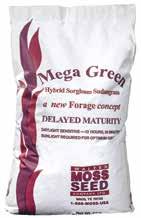
5. Preheat oven to 350 F
6. Bake for 20 minutes
7. While baking, combine all topping ingredients in a bowl until crumbly
8. Remove French toast from oven and sprinkle crumble topping over it
9. Bake for an additional 20-25 minutes
10. Serve immediately with fresh strawberries, syrup or powdered sugar
11. Enjoy!
68 Cooperative Farming News www.MossSeed.com 1-888-MOSS-USA Call for the dealer nearest you! Photoperiod Sensitive Sorghum Sudan Grass Mega Green - No seed head all summer long -Up to 24 - 4” leaves per plant - 3 to 4 times the yield - Lower seeding rate - Drought tolerant - Higher weight gains -Unbelievable regrowth CLAY COUNTY STOCKYARD 1050 Airport Road - Ashland, AL Sale Every Tuesday at 12:30 p.m. Tad and Kim Eason, Owners Barn: 256-354-2276 Tad: 397-4428 Hauling available Check us out on Facebook! SAND MOUNTAIN STOCKYARD, LLC 19509 AL Hwy 68 - Crossville, AL 256-561-3434 Cattle Auction - Every Wed. & Sat. at 11:30 a.m. Call for any hauling & catching needs VALLEY STOCKYARD 13130 AL HWY 157 - Moulton, AL Cattle Auction - Wed. at 11:00 a.m. Nick Lovell (C) 256-777-3363 Phone: 256-974-5900 Fax: 256-974-5899 Your Full Service Stockyard MID STATE STOCKYARDS TOP RANKED MARKET RECEIPTS SINCE 2006 8415 State HWY 97 South Letohatchee, AL 36047 Sale Day: Tuesday at 10:00 a.m. 1-877-334-5229 or 334-227-8000 www.midstatestockyards.com
you would like to advertise your stockyard, please contact Wendy McFarland at mcfarlandadvantage@gmail.com
If
BY LOIS TRIGG CHAPLIN
BIRDS FOR PEST CONTROL

Although they are annoying when they pick at my figs, blueberries and tomatoes, truth is that we generally have enough fruit to share with the birds, or we cover the berries with netting. I have come to the conclusion that I would rather have a garden with birds than without. They help us contain the caterpillars, and we enjoy their songs and antics! Between the birds and the beneficial insects, most caterpillar outbreaks disappear quickly. I am especially grateful during the cool months, for greens and broccoli are crops that can be quickly ruined by cabbageworms and armyworms. We are happy to see the bluebirds and cardinals perching and hunting in our garden through the winter. However, the greatest spring and summer source of caterpillars for many of our native birds are those that we never see – way up in the canopy of our native trees. That’s why it’s a good idea to have some big oaks and other native trees in the yard. Watching a pair of bluebirds come and go as they feed their chicks is great entertainment. So keeping some bird houses clean and in good shape along with some water for the birds pretty much keeps several families or year-round residents close enough for year-round pest control.
OLD-FASHIONED SCENTS

The sweet, clove-like spicy fragrance of old-fashioned pinks is a treat from the past. At one time, this perennial was easy to find in garden centers, but not as much today. Plants go in and out of style just like fashion, but in our garden it’s a classic. Thankfully, pinks can live for years in a sunny spot with good drainage. This plant forms a lovely mat of nearly evergreen foliage that looks good in the garden year-round. Ours is ‘Bath’s Pink’, but here are many cultivars with leaves that range from green to silvery, depending on the selection. One of the hallmarks of pinks is fringed petals, and of course the fragrance. ‘Bath’s Pink’ (Dianthus gratianopolitanus), which was named after Georgia grower Jane Bath, has single pink flowers with a darker pink inner ring. To care for pinks, shear off the flowering stems after they finish blooming, along with any dead portions of the plant, and about a third of the foliage. As a clump spreads, you can divide it every third or fourth year to freshen it and share pieces with friends. Look for starts of pinks at your favorite nursery, mail-order source or a friend’s garden! Stems root as they grow along the top of the ground, so pieces are easy to dig and separate from the mother plant.
 This bluebird helped keep the caterpillar population in balance
Pinks grow into a pretty fragrant mat
This bluebird helped keep the caterpillar population in balance
Pinks grow into a pretty fragrant mat
…AND YOU GET GREENS AGAIN
Last spring our mustard greens were a handsome sight as the yellow flowers appeared and then developed ripe seed. During summer sparrows and other small, seed-eating birds feasted on the thousands of seeds for several weeks. After the seed heads were stripped of their seeds, I composted what was left of the plants. Later that summer, a new crop of mustard volunteered from seeds that had dropped to the ground in the bed and path. It was a small job to pull the ones in the path with one good harvest last fall. Those in the bed were left to continue produce several harvests through winter and spring so that now we have a freezer full of easy, self-seeded greens. The idea of a self-perpetuating mustard patch sounds pretty good, so I am letting it repeat this year, too. The plants that reseed may be too close together in some places, and farther apart in others, so a little thinning and perhaps transplanting may be in order, depending on how fastidious one chooses to be.
PLANT SOME SINGLE ZINNIAS, TOO

The fanciest, fullest zinnia blossoms are prized for their beauty as cut flowers to bring indoors, but if you want to attract the most butterflies, bees and birds to the garden, choose the simple ones with only one or two rows of petals. Usually called ‘single’ or ‘semi-double,’ their flat-topped blossoms provide a resting spot and easier access for insects and birds to reach the pollen and nectar offered by the flower. Some birds also feed on small beetles and other insects that are more visible on the simple blossom. Goldfinches like flat-topped zinnias as they are often seen tearing off flower petals to reach the developing seed meats at the base of the flower. Fancy full-flowered cultivars far outnumber the single-flowered types, but here are names of some singles to look for: ‘Forecast’, ‘Old
Mexico’, ‘Peruvian zinnia’, ‘Pinwheel’ and ‘Zahara’. State Fair is a mix that includes some singles, too. Save seeds from single types in your garden and keep selecting each year.
SOFT TIES FOR TOMATO PLANTS

Tomato stems are easy to bruise when tying, so it helps to use a soft, stretchy tie. Pantyhose are soft, stretchy and easy to cut. You can use old ones, or buy inexpensive ones at a dollar store. Simply cut into strips and use them to attach wayward stems to trellis, stake or cage. They work to shore up fruit-laden peppers and eggplant branches to a support, too.

70 Cooperative Farming News
Butterflies and pollinators like the flat-topped zinnias best
Pantyhose strips make soft plant ties
Mustard Green bloom
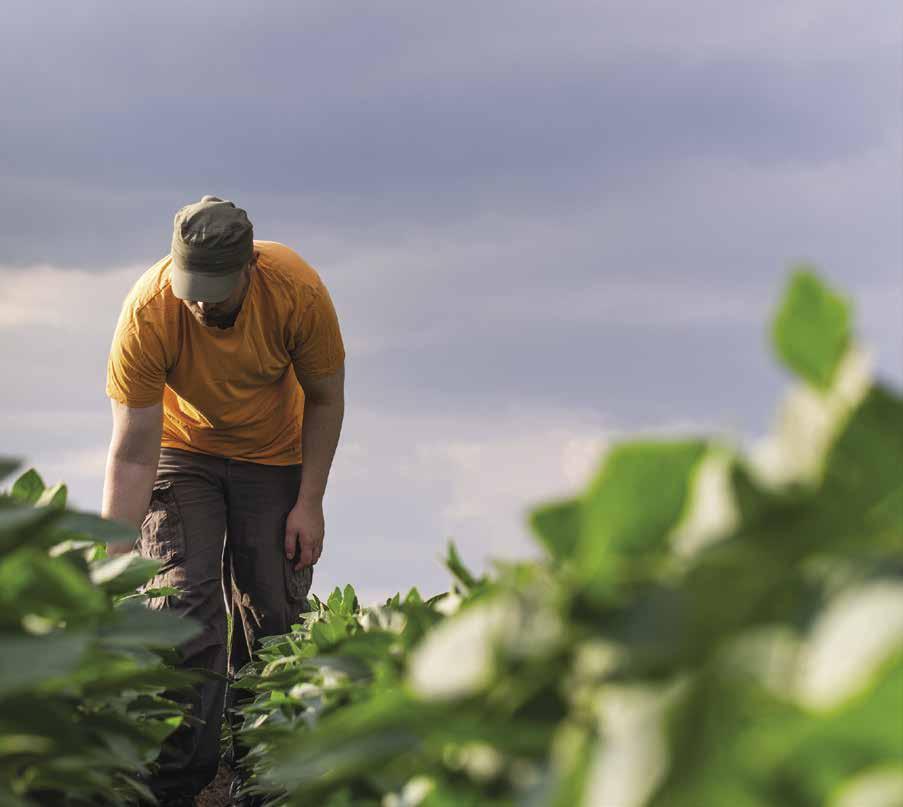


April/May 2022 71 Is a dangerous grass threatening your crop or LAND? Cogongrass is damaging Alabama’s landscapes. Agriculture and natural ecosystems are at risk. Report it now on the SEEDN (Southeast Early Detection Network) app, available for Apple® and Android® devices. Learn how to identify it and how to report it. Alabama Department of Agriculture and Industries www.alcogongrass.com (334) 240-7225

72 Cooperative Farming News APRIL IS NATIONAL GARDENING MONTH Advertise with Cooperative Farming News Contact Wendy McFarland Today! 334-652-9080 or McFarlandAdvantage@gmail.com Got an event, sale, or product you want to advertise with us? Cooperative Farming News reaches over 11,000 subscribers and countless more from our online presence and Co-op store copies.
BY JOHN HOWLE

GET YOUR GARDEN GROWING
April and May are two exciting months in Alabama to get your garden growing. Being able to provide your family with food you grew yourself gives a level of independence that is unmatched. Whether it be a backyard garden, farm-raised chicken and eggs, or a cow you are having processed, it’s always a wise choice to be food independent.
Plant the Produce
April is a great month to get those garden seeds into the ground once the threat of frost is over. During mid-to-late April in Alabama, you can plant corn, squash, green beans, butterbeans and tomatoes. For crops such as okra, you will want to plant later in May when the soil temperature is higher.

Typically, if you plant in mid-to-late April, your squash will come in first. If you keep the squash picked regularly, it will continue to produce for a couple of months. Squash can be boiled, fried or grilled.

best part of canning is no electricity is required. Simply store the canned glass jars on a shelf out of the sun, and you’ve got food that can be stored for years.
If you are planning to freeze the excess produce, typically you blanch the vegetables before storing in freezer bags for long term. Cream corn, okra, peas and butterbeans are easy items to freeze for long-term storage.
Best Meat to Eat
In addition to vegetables that can be stored longterm, make sure you stock up on your meats. Pasture-raised beef and poultry are healthy items that can be frozen and stored long term. If you are raising beef, find a processor in your area that can cut the meat up in your desired specifications. If we are raising a beef that is naturally fat and well-marbled, I’ll have the beef cut up into retail cuts such as ribeyes, filets and roasts. If it is a cow that runs on the lean side, I’ll simply have the entire beef cut up in ground beef. If the cow is lean, ground beef is much more forgiving when grilled on the grill.
It’s also a great idea to add chickens to your farming operation. Not only will you get fresh eggs each day, the chickens eat a lot of items that you would normally throw away. Discarded cabbage, squash that is too big and old to eat, beef fat, bread, and other items can be quickly digested by the chickens.
If you plant a large-enough garden, you can have vegetables all year long. My favorite way to prepare and store food for long term is by canning. I typically can squash, green beans and tomatoes, but any produce can be canned for long-term storage. The

When the chickens get too old to lay eggs you can have healthy meat as well. If you fill a large pot with

74 Cooperative Farming News
Chickens: Keeping some pasture-raised chickens will provide you with meat and eggs. In addition, they are two-legged garbage disposals eating much of the old produce you might throw away.
Green beans and other vegetables can be canned for long-term storage requiring no electricity.
Squash can be boiled, fried or grilled and if picked regularly, will provide longterm produce.
water and get the temp up to 150 F, dip the entire chicken into the hot water for two minutes. The feathers will practically fall off. Finally, remove the head, feet, and entrails and place in a freezer bag if you plan to eat the chicken later. An entire chicken placed in a crockpot with a can of cream of mushroom soup, carrots, onions and potatoes makes a tender, delicious meal.
What to Grill?
This is a great time of year for grilling not only your meats but your vegetables as well. Corn, squash and full-length okra complement any meat on the grill and that flame-grilled flavor is hard to beat. It is truly a satisfying feeling to grow all your own meat and vegetables, and it’s a good idea to be able to run to the garden instead of run to the government when you are hungry.

Great Bait
This is a great time of year to catch some fresh fish for the fryer. Live bait works well for catching pan fish and bass. One of the best baits I’ve used this time of year are grubs. A productive place to find these baits is under round bales of hay. The grubs have a thick layer of skin, and I’ve often been able to catch two or three fish on the same grub. Simply roll the round bale over and you can often find grub worms underneath.

The Perfect Pruner

Anvil-style pruners are a great tool to keep in your pocket in the outdoors while hunting or completing farm work. If you are turkey hunting, the pruners allow you to open up your field of vision even in thick cover, which is essential when hunting hesitant toms. If you are repairing fences, it seems like the fence only breaks down in areas around saw briers, vines, and other obstacles. With anvil-style pruners, you can quickly clear the work area of these annoying vines. Anvil pruners have a cutting style that allows one sharp blade to cut through the vine against the flat, anvil surface.
Take some time between tending your garden and making hay to get out and enjoy the outdoors.
April/May 2022 75
It’s a satisfying feeling to fill a plate with everything you grew on the farm.
Grubs can be found under round bales, and they make great fishing bait.
An anvil-style pruner is a handy tool to keep around while in the outdoors.
SPIN THE COLOR WHEEL

GARDENING DOESN’T HAVE TO BE SO METHODICAL!
BY BETHANY O’REAR
A color wheel is that magical circle which helps us understand the relationship among colors. The primary colors yellow, blue, and red are the anchors and their combinations fill out the balance. To the adventurous home gardener, a color wheel is an inspiration, sometimes even a challenge. Let’s explore some of the fantastically-hued vegetables and satisfying flower rainbows you can plant this spring.
In Central Alabama, corn can be planted any time between March 10 and June 30. Wait until the soil warms up and dries out a bit and then sow blocks
of ‘Glass Gem’ corn. A Native American cultivar, its kernels are jewel-colored and seem to shimmer under the light. Related varieties are sold as ornamental seed, but classic ‘Glass Gem’ is edible, typically in popcorn form.
Eggplants are known in Europe as “aubergines” – the French word for the color violet. But you can grow pure white eggplant called ‘Casper White’, the deep black heirloom ‘Black Beauty’, or the beautifully marbleized ‘Rosa Bianca.’ Eggplant should be sown indoors until several inches high and transplanted
76 Cooperative Farming News
MAGIC OF GARDENING
outdoors after frost between mid-April and mid-May. Blue and purple podded heirloom snow peas can be direct sown right up until the last frost. As the name suggests, these beautiful vining peas have colorful pods but open to bright green peas. Harvested just as the pods start to form peas, it is eaten whole. If the peas are allowed to fully form, treat as a shell pea. Grown alongside ‘Golden Sweet’ snow pea, your vegetable garden will be anything but boring.
Peppers are a popular transplant which can be set out from April 1 to May 15. There are many lovely pepper types to choose from, but few can beat the chili pepper ‘Hungarian Yellow Wax’. Miniature sweet peppers, ‘Sweet Cherry’, come in bright red and yellow varieties like small ornaments. For those who like banana peppers, ‘Goddess’ is a pale yellow, perfect for slicing. There are hundreds of types to choose from – spend a little extra time at the farmers market this year to see if any others catch your fancy.
Many home gardeners have a favorite go-to type of tomato. That’s no reason not to leave a little space for an unusual, black-colored tomato. They come in all types and sizes: ‘Indigo Rose’, ‘Black Beauty Beefsteak’ and ‘Black Beauty Slicer’ are all popular. At the other end of the color spectrum are bright yellow and golden tomatoes. Particularly appealing is the lower-acid disease-resistant ‘Lemon Boy’. ‘Goliath Sunny Hybrid’ is ripe at a bright yellow hue that sweetens to gold. ‘Lemon Drop’ produces diminutive fruit that can be eaten off the vine.


Playing with color in the vegetable patch is something of a novelty but using color effectively in the
ornamental landscape is an art. To use colors to your advantage, choose a strategy and stick to it. A monochromatic color scheme uses one color with closely related tints or shades of the same color. Accents are typically a neutral white or silver. Formal bedding arrangements often feature swaths of dark red plants such as scarlet salvia, begonias or geraniums, accented by white colored plants of the same variety or an accent plant such as Euphorbia ‘Diamond Delight’.
Analogous color schemes use two colors adjacent to each other on the color wheel. For example, purple and pink Angelonia can be interplanted with Pentas in the same shades. The differing flower structures and green leaves provide just enough contrast to look naturalistic. A more dramatic pairing of analogous colored plants would be Purple Shield and lavender and purple Pentas.
Complementary colors draw from opposite sides of the wheel. The flower garden offers many attractive purple and yellow combinations such as ‘Homestead Purple’ Verbena and ‘Moonbeam’ Coreopsis. ‘Coronation Gold’ yarrow and purple Lantana are another striking plant grouping. Orange doesn’t always play nicely with others in the flower garden but if you remember that it is complemented by green on the other side of the wheel, endless opportunities for foliage accents are revealed.
Whatever color scheme you choose, make sure to review the lighting before making final selections. Colors and accents are dramatically affected by sunlight and shade intensity. Bright sun can “burn” out the subtlety of pairings while deep shade can dampen color in favor of white or silver accents. Don’t rely on memory--take photos over a day or two and compare. Of course, as any seasoned gardener will tell you, even if you make a mistake, there’s nothing a shovel or frost can’t fix. Happy gardening!
April/May 2022 77
Black Beauty Eggplant (Photo Credit: Lucy Edwards, Alabama Extension) Indigo Rose Cherry Tomato (Photo Credit: Chris Becker, Alabama Extension)
LAWN & GARDEN CHECKLIST
April Garden Checklist
Fruits and Nuts
• Season for strawberry planting continues.
• Start spray program for all fruits.
• Plant raspberries and blackberries and continue budding apples and peaches.
Shrubs
• Prune spring flowering shrubs after flowering.
• Fertilize azaleas and camellias.
• Spray all shrubs with a fungicide as new growth begins to mature.
Lawns
• Planting new lawns continues.
• When daytime temperatures are consistently above 70 degrees F, apply fire ant bait. Read the label carefully for best control.
• Start a mowing routine as spring growth begins.
• Monitor the thatch layer in bermudagrass and zoysiagrass lawns. Dethatch if thicker than 1⁄2 inch. Wait until active growth.
• Monitor for fungal disease in wet, cool weather.
• Fertilize warm-season lawns after fully green.
Roses
• Watch for insects and diseases.
• Keep old flower heads removed.
• Plant container-grown plants from nurseries or garden centers.
Annuals and Perennials
• Plant early-started annuals or bedding plants from nurseries or garden centers.
• Divide mums or root cuttings. Dig and divide dahlias.
Bulbs
• Plant gladiolus, fancy-leaved caladiums, milk and wine lilies, and ginger and gloriosa lilies.
• Apply super phosphate to bearded iris and scout for iris borer moth caterpillars.
• Avoid cutting foliage of narcissus or other bulbs until it has turned brown naturally.
Miscellaneous
• Spray camellias, hollies, etc., for scale insects.
• Carefully water new plantings of shrubs and trees.
• Pinch out tips of new shoots to promote more compact shrubs.
Vegetable Seeds
• South: Plant heat-loving crops, such as okra. Continue planting other frost-tender crops.
• South and Central: Continue planting frost-tender vegetables (beans, southern peas, corn, squash, melons, and cucumbers).
• North: Wait until late April to plant beans, cucumbers, melons, southern peas, and squash. Plant sweet corn each week for a staggered summer harvest.
Vegetable Transplants
• Whole state: Plant transplants of tomato, pepper, and eggplant.
• South: Plant certified sweet potato slips.
• North and Central: Plant sweet potato slips in late April.
May Garden Checklist
Fruits and Nuts
• Continue spray program.
• Keep grass from around trees and strawberries.
• Peaches and apples can still be budded.
Shrubs
• Newly-planted shrubs need extra care now and in coming weeks.
• Do not spray with horticultural oils when the temperature is above 85 degrees F.
Lawns
• Start new lawns from seed.
• Call the Master Gardener Helpline at (877) 252-4769 to learn more about seasonal fertilizer use and proper mowing. Overfertilizing and overwatering lead to lawn problems.
• Wait until warm-season lawns are fully green before applying any fertilizers.
• Mow often (5 to 10 days) to remove just 1/3 the grass height at each mowing.
• Apply 1 pound nitrogen per 1,000 square feet to all warm-season lawn types: bermudagrass, centipedegrass, St. Augustinegrass, and zoysiagrass (or wait until after dethatching).
• Dethatch warm-season lawns if needed. Check thatch layer, as in April. Water and fertilize after dethatching (1 pound nitrogen per 1,000 square feet).
Roses
• Spray or dust for insects and diseases.
• Fertilize monthly according to a soil test.
• Plant container-grown plants in flower.
• Prune climbing roses after the first big flush of flowering.
Annuals and Perennials
• Late plantings of bedding plants still have time to produce.
• Watch for insects on day lilies.
Bulbs
• Summer bulbs started in containers may still be planted.
• Do not remove foliage from spring-flowering bulbs.
• Do not let seedheads form on tulips and other spring-flowering bulbs.

Miscellaneous
• Mulch new shrub plantings if not already done.
• Monitor new landscape plantings of shrubs, trees, and turf. To establish healthy root systems, prevent them from drying out and water deeply.
Vegetable Seeds
• Whole state: Continue plantings of all April seeds across the state.
• Central and North: Add okra and southern peas to your garden.
Vegetable Transplants
• Whole state: Continue plantings of April transplant crops.
• Central and North: Plant certified sweet potato slips.
78 Cooperative Farming News
BY SUZY M c CRAY
DON’T CALL US HOBBY FARMERS
When I was struggling so badly on this farm basically all alone, I bristled if someone called me a “hobby farmer.”

When I was fighting to thaw out a gate latch using warm water carried from inside the house to the goat pen with my fingers freezing inside my tattered gloves OR when I had spent all morning in near 100-degree weather delivering twin baby goats and literally breathing (and praying) life into their nostrils, the term “hobby” just didn’t seem fitting!
None of my animal sheds were squared up and all the fencing was repaired with miles of baling wire and even zip ties. But the animals were warm and safe, and they seemed happy. I worked from sunup in the mornings until often after sundown so it certainly didn’t feel like a hobby to me.
When my good friend and former Gadsden Times News Correspondent Darrell Norman wrote an article about my farm and my first book back in 2014, he titled it “Don’t Ever Call This Woman a Hobby Farmer.”

And that was pretty much the way I felt back then!
I looked up the term “hobby farm” on Wikipedia and it said that a hobby farm was basically a farm where you didn’t depend on the income. That if you lost income on a hobby farm, it was basically a disappointment not a disaster.
Then there was a guy called Tree Hugger on that internet that said a hobby farmer can have different definitions. But the basic idea is that “a hobby farm is a small-scale farm that is primarily used for pleasure instead of being a business venture. The owner or owners of a hobby farm typically have a main source of income like an off-farm job or pension or retirement income.” Whatever the source, his point is that the farm does not have to make money. It can be engaged in on a hobby level so if one season yield isn’t favorable it is considered more of a disappointment rather than a financial loss.
But when I was covered in manure, dirt, sweat and sometimes blood, it sure didn’t feel like a “hobby” to me even after reading all that!

When I was growing up, it seemed that everybody in our small agricultural community of Alabama grew gardens in their backyards, even in town, and they processed the food by freezing or drying or canning for the long winters. They weren’t labeled. It wasn’t anything special. It was just what everybody did then. My grandparents in Oneonta had a lengthy vegetable garden surrounding two sides of their city lot, a worm bed across the back, and flowers all in between! I can remember Granny Inmon drying apples on a window screen in her backyard, bringing it in every night until the apples were crispy and brown. And although by that time in their lives, Grandpa did most of the cooking, in late summer the kitchen turned back into Granny’s domain as she canned jar after jar of delicious vegetable soup!
For many years folks began to slowly get away from that. Why bother to can food at home when you could go in the grocery store and get it seemingly for even lesser cost? There were some religious groups that advised their parishioners to have at least a year
to two years of food in their pantries not because of a national disaster that might be expected but in case of job loss, illness, or other problems that would prevent them from going to the store and affording additional food.
When I was a young teenager, I guess going through what people called my “hippie stage” (which was yet another label that I didn’t like), I began experimenting with homesteading and the back-to-the-land movement.
When Y2K came along a lot of people saw that they might need to store food but many were embarrassed later when no big disaster happened and everybody kind of got away from it again. I always tried to have at least six months of food on hand. That was about all I could do and most of that was canned food that I got from the store, buying an extra can of this or an extra bottle of that whenever I could and canning and freezing what I could in my small way. When I saw the importance of that was when my late husband had the first of two heart attacks. We were at home for about six months with his specialist advising me not to shop in the big box stores fearful I would bring germs back to him – this was a decade and a half ago. So guess what we ate for those six months? Basically food out of my six-month storage pantry!
After his death, it was even more crucial for me to have food on hand as my income was off and on-dependent on what season my small homestead was in.
As I raised hundreds of heirloom plants in my tiny playhouse-sized greenhouse, there were several people who would come and ask me advice about plants even though I was certainly not an agricultural genius. But I talked to many who lived in public housing about how they could grow tomato plants and other plants in buckets on their small porches. One lady planted a straggly tomato plant between her shrubbery. She called me every week that summer detailing to me how many large tomatoes she got off that one plant and how many sandwiches she made.
Along about the time I was first widowed I was
80 Cooperative Farming News
”
AND WHILE WE SUPPORT THE LARGER AGRICULTURE BUSINESSES, AND ARE AMAZED AT THE VOLUME OF THEIR CROPS, THERE’S JUST SOMETHING ABOUT GOING IN YOUR OWN BACKYARD AND PICKING YOUR SUPPER AND THEN COOKING IT AND EATING IT!
blessed to have a scholarship to attend the Annie’s Project program for women in agriculture through our county Extension Service. As we studied finances and different ideas about women in agriculture I soon found that while my profits were not huge on my little farm, my profit margin was as good or as better as some of the larger agricultural businesses that surrounded us. While I still was troubled by “labels” as I worked day in and day out that little tidbit of information helped my feelings quite a bit!
Slowly it seems that the overall ideas of folks in our communities and in our country have been that we need to be more responsible for our own food. And while we support the larger agriculture businesses, and are amazed at the volume of their crops, there’s just something about going in your own backyard and picking your supper and then cooking it and eating it! There’s just a certain pride in knowing that you grow the food with God’s blessings! During the last few years we’ve seen some frightening things with some store shelves being empty and it’s made us think once again. There’s been a shortage of canning jars, canning lids, even freezers and other items, including seed, as people suddenly decided they all wanted to get back into being more responsible for what happens in their own little area of their lives for their families. Even some of the larger hatcheries have told how there were waiting lists for day-old baby chicks.
So, while there seems to be a wonderful place for the agriculture that we have in the United States where one farmer can feed hundreds of folks, there also seems to be a return to the backyard farmer, whether you call us hobby farmers, backyard farmers, or just folks who are concerned about our own food. You can grow a lot between your shrubbery. You can grow a lot in containers. Dan Porch, who was the former Auburn Extension agent in Blount County, hosted container gardening seminars that were so insightful. The Extension Service is a wealth of information about those kind of things as are your local Co-ops. Your local Co-ops can tell you what plants and what seeds are good for your area and what will flourish and what probably won’t even in your small beds!
Right now, Mack is building me several small beds for my herb gardens. He’s building them taller so that I will not have to bend as much as I’m not as young as I used to be. He makes a huge garden every year and we’ve been able to sell some of the produce, but we bought a new canner three years ago because we can basically all the time from early spring until well into winter. Does that make us hobby farmers? I don’t think so. I still prefer to think beyond the labels.
When Darrell wrote that article eight years ago, he talked about my “simple life,” and noted how many of my Co-op articles which were in that first book “is at once a tribute by many generations of her family, a history of the land she holds, a memoir of personal loss and faith, a hymn to hard work, an anthem of independence and a textbook on how to live with dirty hands and an open heart.” He also said my words were “a testament to old-fashioned ways that still hold the power to nurture body and soul.”
Darrell’s words, as do that of Paul’s in the New Testament, show that the hundreds – thousands –of us loving our land and our work on our tiny or big farms don’t need labels about our simple lives.


As Paul urged us in 1 Thessalonians 4:11-12, “And that ye study to be quiet, and to do your own business, and to work with your own hands, as we commanded you; That ye may walk honestly toward them that are without, and that ye may have lack of nothing.”
(Suzy and husband Mack live on a homestead in Blount County, Alabama and can be reached on Facebook or by email at suzy.mccray@yahoo.com)






April/May 2022 81
STOP DAMAGE EARLY IN THE SEASON WITH SHAKE-AWAY! Creates the illusion predators are present in your lawn and garden. Easy to use and long lasting! For more product information call (203)-230-9207 or visit www.shake-away.com TM





82 Cooperative Farming News Castine Blend™ Organic & Natural Raised Bed Mix Monhegan Blend™ Organic & Natural Black Earth Lawn Soil! For Organic Use OMRI.org www.coastofmaine.com Coast of Maine Something Bugging You? Available ONLY To Independent Retailers www.Hi-Yield.com
PLAN AHEAD FOR FOOD PRESERVATION SEASON HAVE THESE THINGS IN PLACE BEFORE STARTING
 BY ANGELA TREADAWAY
BY ANGELA TREADAWAY
Growing and preserving your own food lets you enjoy delicious, in-season fruits and vegetables throughout the year. For many of us, who may not have our very own home garden, there is still a way we can capture the great quality and flavor of fresh fruits and vegetables and indulge all year. There are many farmers markets now throughout the state and there is probably one in your community or nearby. These fruit and vegetable growers offer a wide variety of fresh fruits and vegetables, notably squash,
okra, greens and of course those sweet watermelons during the summer months. If you are thinking about canning as a way to preserve your food this summer, there are a couple of things you should have in place before getting started.
RECIPES:
All home canned foods should be prepared using research-tested recipes. Research is done continually to provide the latest, most up-to-date recommenda-
April/May 2022 83
FOOD SAFETY
tions. Many new guidelines have been released over the last couple of years, so make sure your recipes have the latest information to keep your family safe. The Extension office in your county will be able to provide you with this information. There are many websites online that have recipes, but you want to be careful to use a website that is from a safe source like the Extension Service or USDA-tested recipes. Following some websites that do not have tested recipes especially for vegetable preservation can be very dangerous.
EQUIPMENT:
Review the equipment needed for canning and make sure they are ready in advance. A water bath canner is needed for processing fruits and a large pressure canner is essential for vegetables, meats, fish and other low-acid foods. You should also have a sharp knife, jars, measuring cups, new lids, a funnel, sugar, salt, rings and a jar lifter. Check your jars for chipping, check gaskets for damage and then call your County Extension Office to request a day that you wish to have your pressure canner gauge tested. Gauges should be checked every year for accuracy (there is no charge to have it checked). While there, pick up a Home Food Preservation information pamphlet.
CANNING PROCESS:



The canning process should begin as each fruit or vegetable is being harvested. For a nicer product, try to use fruit or vegetables without any sign of insect damage, bruising or wilting. The first step will be to sterilize your jars. As you prepare your recipe, get your canner on the stove. Next, fill your jars according to the directions and then seal. After removing them from the canner, put them onto a dry, clean, cloth where they can sit for the next 24 hours. The following morning, you should check to make sure you have a good seal. If sealed properly clean, label and store to enjoy later in the year or in the winter.
STORAGE:
You want to make sure that you have a good storage area; after all you’ve put in a lot of work. Most canned food items are good for up to a year. For a complete list, you may download an Extension Publication, “Better Safe than Sorry Food Storage Chart,” or request one from your County Office. There are many other publications available for home food preservers at this website: www.aces.edu. You may also visit the University of Georgia’ website for more information at: www.uga.edu/nchfp/.

84 Cooperative Farming News
For more questions on Food Preservation please contact one of your local Regional Agents in Food Safety & Quality:


• Angela Treadaway at 205-410-3696 or email is atreadaw@aces.edu
• Christy Mendoza at 205-217-6495 or email is cnm0012@aces.edu
• April Susan Hill at 205-269-1748 or email is hillaps@aces.edu




• Janet Johnson at 334-703-2237 or email is johns16@aces.edu
• Bridgette Brannon at 334-714-1248 or email is huttobf@aces.edu
• Alice Moore at 334-216-0738 or email is amm0167@auburn.edu
• Rebecca Catalena at 251-234-1020 or email is rjc0026@auburn.edu
• Dani Reams at 256-368-1694 or email is
April/May 2022 85
DAREPRODUCTS.COM | 1.800.922.3273 LEARN ABOUT THE DARE ADVANTAGE - HOW IT WORKS - FENCE DESIGN TOOL - PRODUCT VIDEOS - STORE LOCATER ELECTRIC FENCING O VE R 75 YEA RS OF SCAN THE QR CODE
WHAT IS IN YOUR HAND?

DISCOVERING THE HIDDEN POTENTIAL IN ORDINARY THINGS
BY GREG A. LANE
There is a music stand at church that I had been using for several months to hold my guitar chord sheets. I could fit two sheets comfortably on the stand and, if worse came to worst, I could squeeze a third one in as well. Considering that I usually have at least six music sheets to spread out, though, the music stand was always a little bit inadequate for my liking. But I continued to use the stand, because there weren’t any others available for me to use.
One day, I had more than six music sheets that needed to fit on the stand. So, with a slight hint of frustration in my voice, I asked, “Is there a wider music stand around here that I can use? This one’s way too small.” Someone replied, “No, there aren’t any others, but that stand you’re using right now slides out to become twice as wide.” I looked down at the stand I had been using for well over three months. I had always wondered why it had the slit in the middle of it. NOW I KNEW! I pulled the two outer edges of the stand outward, and it expanded to twice its original width. I felt completely ignorant. I could have been using this stand the way it was intended to be used months earlier, but I was completely unaware of how versatile it was until I got a revelation of it firsthand.
Isn’t that the way life goes? You’re doing the very best you can with what you have in front of you, only to find out that what you’ve been given has greater purpose and meaning than you ever imagined. Un-
less someone comes along and opens your eyes to the truth you’ve overlooked, you could actually go to your grave missing out on the wonderful blessing you’ve had right in front of you all along … the marvelous potential in the thing you thought was ineffective or deficient.
Moses got a similar revelation from God one day as

86 Cooperative Farming News
he stood before the burning bush in the wilderness. Doubting his own ability to be the “Deliverer of Israel” God had destined him to be, he asked God, “What if they won’t believe me or listen to me? What if they say, ‘The LORD never appeared to you’?” (Exodus 4:1). God’s simple reply was, “What is in your hand?” Moses answered, “A shepherd’s staff.” God said, “Throw it on the ground.” When Moses did as God requested, his staff became a snake. Moses had carried that staff with him for four decades, completely oblivious to the fact that God would use it as a tool by which he would bring deliverance to the children of Israel.
Using that simple shepherd’s staff, Moses performed wonders and miracles in the land of Egypt. Not only was it used to call down plagues in Egypt, Moses also used it to part the waters of the Red Sea, and to make water flow from the rock in the wilderness to quench the thirst of the children of Israel in their wilderness journey.
prevented it. One day, though, a God-inspired thought came to her. She went through all of the magazines and newspapers that she had collected over the past year and clipped out all of the money-saving coupons she could find. She then categorized them into food products, diapers and formula, and toiletry items. She filled envelopes with several hundred dollars worth of coupons each and gave them to young couples in her church as a gift, to help them out financially during their times of strained finances. She discovered the value and potential in something that she had sitting right in front of her … something that she had most likely overlooked before.
God’s simple reply was, “What is in your hand?”
Moses answered, “A shepherd’s staff.”
Years earlier, Moses had used that staff to gather sheep in the wilderness of Midian. He had leaned upon it when he was tired after a long, hard day of work. He had probably used it for a number of menial tasks during his 40 years of shepherding his fatherin-law’s herds. But, one day, God opened Moses’ eyes to the power and potential in that seemingly insignificant shepherd’s staff.

I heard a story about a poor, widow woman at a church who had a close relationship with the Lord in prayer. She wanted to be able to give financially to help young couples in her church, but her poverty

Some people complain about the “little” bit that they have in life. They look at others who have more and say, “If I only had what they had, I could be successful in life.” But, the truth is, God has given each one of us many things in our lives to help us become successful. All too often, however, we’re completely ignorant of the power and potential in the things He’s put right in front of us. What could you possibly do with the jawbone of a donkey? Samson defeated one thousand Philistines with one. What could you do with five loaves of bread and two small fish? Ask a little boy who gave his sack lunch to Jesus so He could feed 5,000 people. You’d be surprised what can be done with the seemingly insignificant things that lay in front of you right this very moment!
So, today, I’ll ask you the same question that God asked Moses when he stood in front of the burning bush … “What is in your hand?”
April/May 2022 87
The photo above shows the music stand, set up in the way I had been using it for three straight months. I was oblivious to its full potential.
Little did I know that the music stand opened up to accommodate twice the number of music sheets I was accustomed to.

helping you focus on what matters most. Find a local agent. AlfaInsurance.com Farmowner coverage property | Dwelling | machinery | livestock | liability
BY MARY DELPH
All The World’s Alive Again
by Jennifer Gunner
The rabbit hops its gentle step
The lark sings lyric songs
All the world’s alive again
Spring rights the winter’s wrong.
Mother hen protects her chicks
White blossoms are in bloom
All the world’s alive again
No snowy clouds to loom.
A kitten chirps her tiny mew
The child blinks his eyes
All the world’s alive again
A new world crystalized
I don’t often wax poetic, but I love this spring poem. It evokes such wonderful images in your mind. Which of course evokes food and eating in my mind. It is time to get the grill out and cleaned and start cooking. Gather outside, even have a few friends and family members over, and just for a while, watch nature and enjoy.


Lamb Chops with Polenta and Grilled Scallion Sauce

8 lamb rib or loin chops (about 2 pounds)
1 1/2 teaspoons plus 1/8 teaspoon kosher salt, divided
1/2 teaspoon freshly ground black pepper
1 pound prepared polenta, sliced into 1/2” rounds
1/2 cup olive oil, plus more for brushing
1 bunch of scallions, roots trimmed
1 jalapeño, halved lengthwise
1 cup basil leaves, finely chopped
1/4 cup fresh lemon juice
3 Tablespoons plain yogurt
6 cups torn, leafy lettuce, such as green leaf lettuce
1 cup cherries (about 6 ounces), pitted, halved
Season lamb chops with 1 teaspoon salt and 1/2 teaspoon pepper. Prepare a grill or grill pan for medium-high heat. Brush polenta slices lightly with oil on both sides. Working in batches if needed, grill scallions, jalapeño, lamb chops, and polenta slices until lightly charred and an instant-read thermometer inserted into the thickest part of lamb registers 125 degrees for medium-rare, 2–3 minutes per side. The scallions may take a couple minutes longer; you want them to be nice and tender before you remove them from the grill. Finely chop scallions and jala-
peño. Transfer to a medium bowl. Add basil, lemon juice, 1/2 cup oil, and 1/2 tsp. salt and whisk to combine. Transfer 1/4 cup scallion sauce to a large bowl and whisk in yogurt and remaining 1/8 tsp. salt. Add lettuce and cherries and gently toss with your hands until thoroughly coated.
Divide salad among plates. Arrange lamb and polenta alongside; then top both with remaining scallion sauce.
Sweet-and-Spicy Ribs

3/4 cup (packed) light brown sugar
1/4 cup smoked paprika
2 Tablespoons cayenne pepper
2 Tablespoons garlic powder
3 Tablespoons kosher salt, plus more
2 St. Louis-style pork ribs (3–4 pounds each)
1/2 cup (1 stick) unsalted butter
1/2 cup apple cider vinegar
Vegetable oil
Heat oven to 325 F. Combine brown sugar, paprika, cayenne, garlic powder, and 3 Tablespoons salt in a small bowl; set aside 1/4 cup spice mixture. Pat ribs dry with paper towels and rub with remaining spice mixture, massaging into crevices. Wrap each rack in a double layer of foil, crimping edges to seal tightly. Place each foil packet on a rimmed baking sheet and bake until meat is fork-tender at the thickest part but not falling off the bone, 2–3 hours. Let cool. Tear open a corner of each foil packet and carefully pour juices from ribs into a large heatproof measuring cup. Let juices settle, then spoon fat from surface and discard. Heat butter in a medium saucepan over medium heat, stirring often, until it foams, then
browns (do not burn), 5–8 minutes. Add juices from ribs and 1/4 cup reserved spice mixture and bring to a simmer. Cook until reduced by one-third, 15–20 minutes. Remove sauce from heat, add vinegar and season with salt. Prepare grill for medium-high heat; oil grate. Remove ribs from foil and grill, basting with sauce and turning occasionally, until charred in spots, 5–7 minutes. Transfer to a cutting board and let rest 10 minutes. Slice between ribs and serve with remaining sauce.
Grilled Chicken
Kabobs

1 pound boneless skinless chicken breasts cut into 1-inch pieces
1/4 cup olive oil
1/3 cup soy sauce
1/4 cup honey
1 teaspoon minced garlic
Salt and pepper to taste
1 red bell pepper cut into 1-inch pieces
1 yellow bell pepper cut into 1-inch pieces
2 small zucchini cut into 1-inch slices
1 red onion cut into 1-inch pieces
1 Tablespoon chopped parsley
Place the olive oil, soy sauce, honey, garlic and salt and pepper in a large bowl. Whisk to combine. Add the chicken, bell peppers, zucchini and red onion to the bowl. Toss to coat in the marinade. Cover and refriger-
90 Cooperative Farming News
ate for at least 1 hour, or up to 8 hours. Soak wooden skewers in cold water for at least 30 minutes. Preheat grill or grill pan to medium high heat. Thread the chicken and vegetables onto the skewers. Cook for 5-7 minutes on each side or until chicken is cooked through. Sprinkle with parsley and serve.
Note from Mary: Heat the broiler. Coat a sheet pan with cooking spray. Place the skewers in a single layer on the sheet pan. Broil for 5 minutes, then flip the skewers and broil on the other side for 5 more minutes.
Grilled Vegetables #1


Drizzle with olive oil and season with salt and pepper. Grill the skewers for 8 minutes per side or until the vegetables are tender and lightly charred. Remove from the grill, season to taste, and serve with desired sauce or dressing.
Grilled Vegetables #2
1 zucchini
1 yellow squash
1/2 onion
1/2 green bell pepper
1/2 red bell pepper
10 ounces carrots
3/4 eggplant
10 ounces Brussels sprouts
Chopped garlic
Herbes de Provence (thyme, sage, parsley, basil, lavender and rosemary)
Olive oil
Heat a grill. Cut vegetables into 1/2-inch-thick slices. Mix vegetables with a generous amount of garlic and herbes de Provence. Drizzle vegetables with olive oil. Grill vegetables on a hot grill until tender and slightly charred.
1 yellow squash
1 zucchini
8 ounces cremini mushrooms, stemmed
1 small red onion
1 red bell pepper
1 green bell pepper
1 ear fresh corn, cut into 1-inch rounds
Extra-virgin olive oil, for drizzling
Sea salt and freshly ground black pepper
Tzatziki, pesto or Greek dressing for drizzling/ serving
Heat a grill to medium-high and spray with nonstick cooking spray. Cut the vegetables into similar-sized chunks and thread onto 4 metal skewers.
MOBILE CHALLENGE OF CHAMPIONS TRACK MEET
April 1 - 2, 2022
Mobile - Various Locations
Friday: 3:00 - 10:00 p.m.
Saturday: 11:00 a.m. - 6:30 p.m.
Call 251-639-0303
HIGHWAY 22 YARD SALE
April 2, 2022
Alexander City - Various Locations
6:00 a.m. - 5:00 p.m.
Call 334-863-6612
CRAWDAD & MUSIC FESTIVAL
April 2, 2022
Ozark - The Square
9:30 a.m. - 4:00 p.m. Call 334-774-2618
SHADY LADY TRAIL RUN
April 2, 2022
Rogersville - Joe Wheeler State Park
8:00 a.m. - 10:00 p.m. Call 256-740-4141
MARKET ON THE SCOTTSBORO SQUARE
April 2, 2022
Scottsboro - Courthouse Square
9:00 a.m - 4:00 p.m.
Call 256-574-3100
WILSON PICKETT MUSIC AND ARTS FESTIVAL
April 2, 2022
Prattville - Pratt Park and Pratt Park Amphitheatre
10:00 a.m. - 8:00 p.m.
Call 334-565-0850
MAGIC OF MARBLE FESTIVAL 2022
April 5-16, 2022
Sylacauga - Various Locations
Call 256-249-0961
CAMELIA CLASSIC CAR SHOW
April 9, 2022
Mobile - Camp Grace
Registration 8:00 a.m. - 11:00 a.m.
Judging: 11:00 a.m. -1:00 p.m.
Awards: 2:30 p.m.
For more information: info@mobilebaymustangautoclub.org
NOBLE STREET FESTIVAL
April 9, 2022
Anniston - Downtown Call 256-689-5479
TENNESSEE VALLEY HORSEMAN’S ASSOCIATION HORSE SHOW
April 9, 2022
Florence - Robert Walker Memorial Arena
Exhibition Barrels: 3:00 p.m.
Horse Show: 4:00 p.m. Call 256-365-1767
U.S. TEAM ROPING CHAMPIONSHIP; SOUTH ALABAMA CHAMPIONSHIP
April 9-10, 2022
Anniston - Downtown Call 256-689-5479
50TH ANNUAL CALICO FORT ARTS & CRAFTS FAIR
April 9-10, 2022
Fort Deposit - Calico Spirit Drive
9:00 a.m. - 5:00 p.m. Call 334-227-8589
50TH 33RD ANNUAL BALDWIN COUNTY STRAWBERRY FESTIVAL

April 9-10, 2022
Loxley - Loxley Municipal Park Call 251-964-5334
ROSE BLOOM OUT AT BELLINGRATH
April 10-30, 2022
Theodore - Bellingrath Gardends
Admission - 8:00 a.m. - 5:00 p.m. Call 251-973-2217
MONTEVALLO ARTS FEST
April 16, 2022
Montevallo - Orr Park & Parnell
Memorial Library
10:00 a.m. - 5:00 p.m. Call 205-665-3766
GARDENDALE MAGNOLIA FESTIVAL
April 22-23, 2022
Gardendale - Gardendale Civic Center Complex - Admission
Friday: 5:00 - 10:00 p.m.
Saturday: 10:00 a.m. - 5:00 p.m. Call 205-514-6799
ANNUAL BLOOMIN’ FESTIVAL
April 22-24, 2022
Cullman - St. Bernard Prep School & Abbey - Admission
9:00 a.m. - 5:00 p.m. Call 256-739-6682
RACKING HORSE SPRING SHOW
April 24-30, 2022
Decatur - Morgan County Celebration Arena - Admission
6:00 p.m. Call 800-524-6181
92 Cooperative Farming News
TENNESSEE VALLEY HORSEMAN’S ASSOCIATION HORSE SHOW
April 30, 2022
Florence - Robert Walker
Memorial Arena
Exhibition Barrels: 3:00 p.m.
Horse Show: 4:00 p.m.
Call 256-365-1767
PEAK BUTTERFLY SEASON IN THE PURDY BUTTERFLY HOUSE
May 1 - September 30, 2022
Huntsville - Huntsville Botanical
Garden - Admission
5:00 - 8:00 p.m.
Call 256-830-4447
THE GOLDEN HOUR
May 6 - October 7, 2022
Huntsville - Big Spring Park
First Friday of every month. Call 256-883-3754
THE GOLDEN HOUR
May 4 - June 29, 2022
Huntsville - Huntsville Botanical
Garden - Admission
Regular Garden Hours
Call 256-830-4447
HUNTSVILLE ALABAMA
EXOTIC PET EXPO
May 7-8, 2022
Huntsville - Huntsville Jaycees
Building - Admission
Call 256-883-3728
GULF COAST HOT AIR
BALLOON FESTIVAL
May 12-14, 2022
Foley - Foley Sports Park
Admission
Call 251-943-3291
LIMESTONE COUNTY
SHERIFF’S RODEO
May 13, 2022
Athens - Sheriff’s Rodeo Arena
8:00 p.m.
Call 256-232-0111
THUNDER ON THE THREE NOTCH
May 13-14, 2022
Troy - Pioneer Museum of Alabama
10:00 a.m. - 5:00 p.m.
Battle starts at Noon
Call 334-566-3597
TENNESSEE VALLEY HORSEMAN’S ASSOCIATION HORSE SHOW
April 14, 2022
Florence - Robert Walker
Memorial Arena
Exhibition Barrels: 3:00 p.m.
Horse Show: 4:00 p.m.
Call 256-365-1767
HOMESTEAD HOLLOW ARTS AND CRAFTS FESTIVAL
May 14-16, 2022
Springville - Various Locations
9:00 a.m. - 5:00 p.m. Call 205-467-2002
ALABAMA’S 16TH ANNUAL BLUE STAR SALUTE & ARMED FORCES DAY EVENT

May 15, 2022
Mobile - USS ALABAMA Battleship Memorial Park - Admission
10:00 a.m. - 4:00 p.m. Call 251-471-4322
34TH ANNUAL JURIED FINE ARTS & CRAFT FESTIVAL
May 15-16, 2022
Florence - 217 E Tuscaloosa Street
Saturday: 9:00 a.m. - 5:00 p.m.
Sunday: 10:00 a.m. - 5:00 p.m.
Call 256-760-6379
MEMORIAL DAY FIREWORKS
May 17, 2022
Foley - Downtown
Saturday 8:45 p.m.
Call 251-932-2111
2021 LOGAN MARTIN LAKEFEST AND BOAT SHOW
May 18-23, 2022
Pell City - 2801 Stemley Bridge Road
Admission
Friday: Noon - 9:00 p.m.
Saturday: 9:00 a.m. - 9:00 p.m.
Sunday: Noon - 5:00 p.m.
Call 770-826-3524
CATFISH FESTIVAL
May 21, 2022
Scottsboro - Jackson County Park
9:00 a.m. - 5:00 p.m.
Call 256-259-1503
MENTONE RHODODENDRON FESTIVAL
May 21-22, 2022
Mentone - 200 North Cool Street
$5.00 fee for parking
Call 256-845-3957
SEC BASEBALL TOURNAMENT
May 24-29, 2022
Hoover - Hoover Metropolitan Stadium - Admission
Various Times
Call 187-733-2780
TENNESSEE VALLEY HORSEMAN’S ASSOCIATION HORSE SHOW
April 28, 2022
Florence - Robert Walker
Memorial Arena
Exhibition Barrels: 3:00 p.m.
Horse Show: 4:00 p.m.
Call 256-365-1767
RXR FEST
May 27-28, 2022
Alexander City - Russell Crossroads
6:30-9:30 p.m.
Call 256-397-1019
ALABAMA JUBILEE HOT AIR BALLOON CLASSIC
May 28-29, 2022
Decatur - Point Mallard Park
Friday: Noon - 9:00 p.m.
Saturday: 9:00 a.m. - 9:00 p.m.
Sunday: Noon - 5:00 p.m.
Call 256-353-5312
***Please note that some of these events may be postponed or canceled due to COVID-19. Please contact the event directly in order to find out more information about the event.***
April/May 2022 93 “What’s Happening in Alabama” Policy
AFC Cooperative Farming News publishes event listings as space allows, giving preference to agricultural events of regional or statewide interest and those that are annual or one-time events. The magazine assumes no responsibility for the accuracy of information submitted for publication and advises calling ahead to confirm dates, locations, times and
admission fees.
Listings must be received at least two months in advance and will be accepted up to a year in advance.*
The
possible
To be included in the calendar, send listings to: Cooperative Farming News Calendar of Events P.O. Box 2227 Decatur, AL 35609 -oremail to Calendar of Events at subscribe@alafarm.com *Please include name of event, where it will be held (both town and physical location), a phone number for more information, and an email or website.* *Event

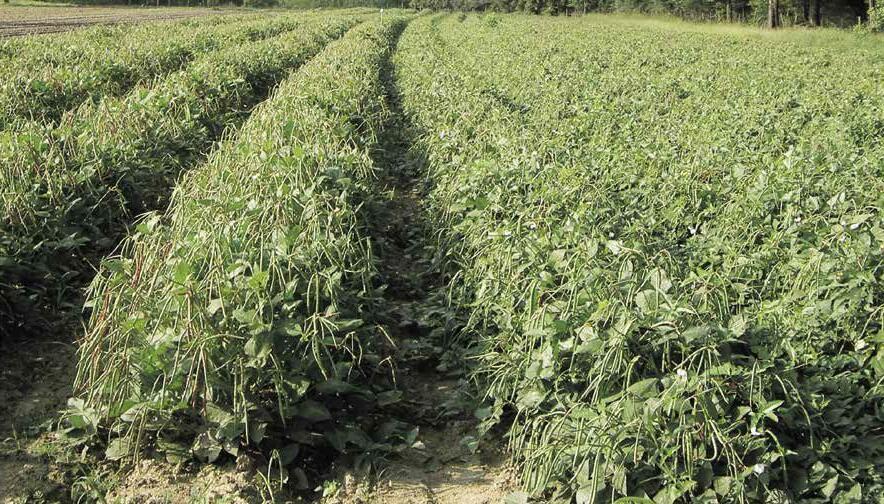

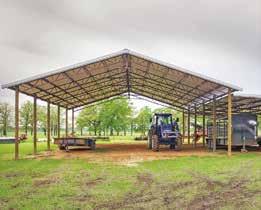




94 Cooperative Farming News Metal Roofing Post Frame Buildings Storage Solutions Pre-Engineered Metal Buildings Call today for a free quote! We now have 2 locations in Florence, AL to help service our customers: 3714 Florence BLVD and 24350 Co Rd 14 Florence, Alabama 35633 Buy Direct and Save! www.reedsmetals.com (256)-764-7943
Top Pick Top Pick
Top Pick Peas gives you top yields plus pods on top of the plant.

Pinkeye Pinkeye Cream Cream Brown Crowder
Crowder
“In the six plus years I have observed peas growing, the Top Pick Pinkeye’s and Top Pick Creams are two of the best peas. They have excellent germination; seedling vigor; high yielding and easy to pick. Plus their food quality is great.
They are good for “U Pick” operations because the peas set on top and the outside of the plant making a real showy bush type plant, which makes it easy for picking by hand and by machine. They are also easy to shell by hand or by sheller and make a good shell out. There are also no problems with disease.


If you have a market operations, you definitely need both types of peas – Top Pick Pinkeye’s and Top Pick Creams. These are by far the best peas on the market today. They are exceptional peas.”
Jason Barkett - J.E.B. Agriculture Consultant



“I grew up farming and I’m impressed with Top Pick Pinkeyed peas. We had early rains and the Top Pick peas loaded up. Some we planted late; some we no-tilled; plus we had more rain, but they really made peas. They pick great and shell out good and best of all they taste great.
We sold them at the Fresh Market, along with shelled peas. The customers came back asking for Top Pick peas. We will plant more Top Pick Pinkeyed peas next year and years to come.”
Bo Levins - Planterville, Alabama
“I first saw Top Pick Pinkeyed peas growing at the E. V. Smith Research Center and really liked the way they put out on top and around the outside of the plant. They were really loaded up with peas.
I have been planting these pinkeyed for ten years now. They produce more than the old bush running pinkeyed purple hull peas. They just out produce any other pinkeyed on the market. They shell out great and taste great.
Top Pick Pinkeyed peas work for me and there is no need to plant any other pinkeyed pea.”

Rob Peacock - Pike Road, Alabama

Seeds for Southern Soils
UTILITY PATENT PROTECTED
“My Top Pick Pinkeye Peas just plain out-yield any other variety I have planted...”
“My Top Pick Pinkeye Peas just plain out-yield any other variety I have planted...”
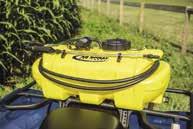
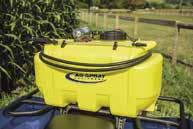
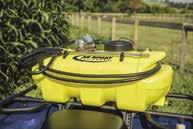


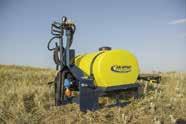

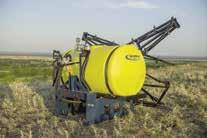
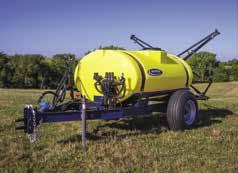























96 Cooperative Farming News LOW PROFILE DELUXE TRAILER SPRAYERS • 500 Gallon Elliptical Tank • Heavy Duty Low Profile Frame • Pressure, Agitation & Strainer Assemblies • Strainer Assy On Top Of Frame In Front Of Tank • Adjustable Hitch Height • 15” Jack • 11L-15 Implement Tread Tires • Hypro 8 Roller Pump Visit A Co-Op Store Near You Or Email Jerry.Ogg@faithwayalliance.com for Participating Stores (Prices Subject To Change) SPRAYING MADE EASY AND AFFORDABLE 12 VOLT SPOT SPRAYERS REPAIR PARTS AVAILABLE AT YOUR LOCAL CO-OP BRONZE 15 Gallon 404799 25 Gallon 404803 SILVER 15 Gallon 404800 25 Gallon 404804 GOLD 15 Gallon 404801 25 Gallon 404805 GOOD BETTER BEST UTV & 3 POINT SPRAYERS 12 Volt 45 Gallon - 454198 12 Volt 65 Gallon - 454079 *Boom Kits Sold Separately 55 GALLON 3 POINT Hamilton - 36’ Swath 404798 BXT - 36’ Swath 404848 7-Nozzle - 140” Swath 480442 110, 150 & 200 GALLON BOOMLESS, 6 & 8 ROW BOOMS IN STOCK LOW PROFILE PASTURE SPRAYERS TR300E-MBXT22PS 300 Gallon 416791 With BXT Boomless Nozzles - 36’ Broadcast Sprays Left Or Right Or Both CALL FOR PRICING PLANT S e SPRING





































 BY JIMMY PARKER
BY JIMMY PARKER
















 FFA members evaluating the cropland site wait patiently for their chance to climb down into the pit to observe the soil layers to evaluate the depth of the soil.
FFA members evaluating the cropland site wait patiently for their chance to climb down into the pit to observe the soil layers to evaluate the depth of the soil.



 BY CAROLYN DRINKARD
BY CAROLYN DRINKARD















































 BY WALT MERRELL
BY WALT MERRELL














 ENTERTAINMENT BY SHELBY DARRALL
ENTERTAINMENT BY SHELBY DARRALL




 (L to R) Addie, Kaylee, Atlas and Seth Hubert.
(L to R) Addie, Kaylee, Atlas and Seth Hubert.












 BY LAURA TUCKER
BY LAURA TUCKER










 This bluebird helped keep the caterpillar population in balance
Pinks grow into a pretty fragrant mat
This bluebird helped keep the caterpillar population in balance
Pinks grow into a pretty fragrant mat


































 BY ANGELA TREADAWAY
BY ANGELA TREADAWAY













































































